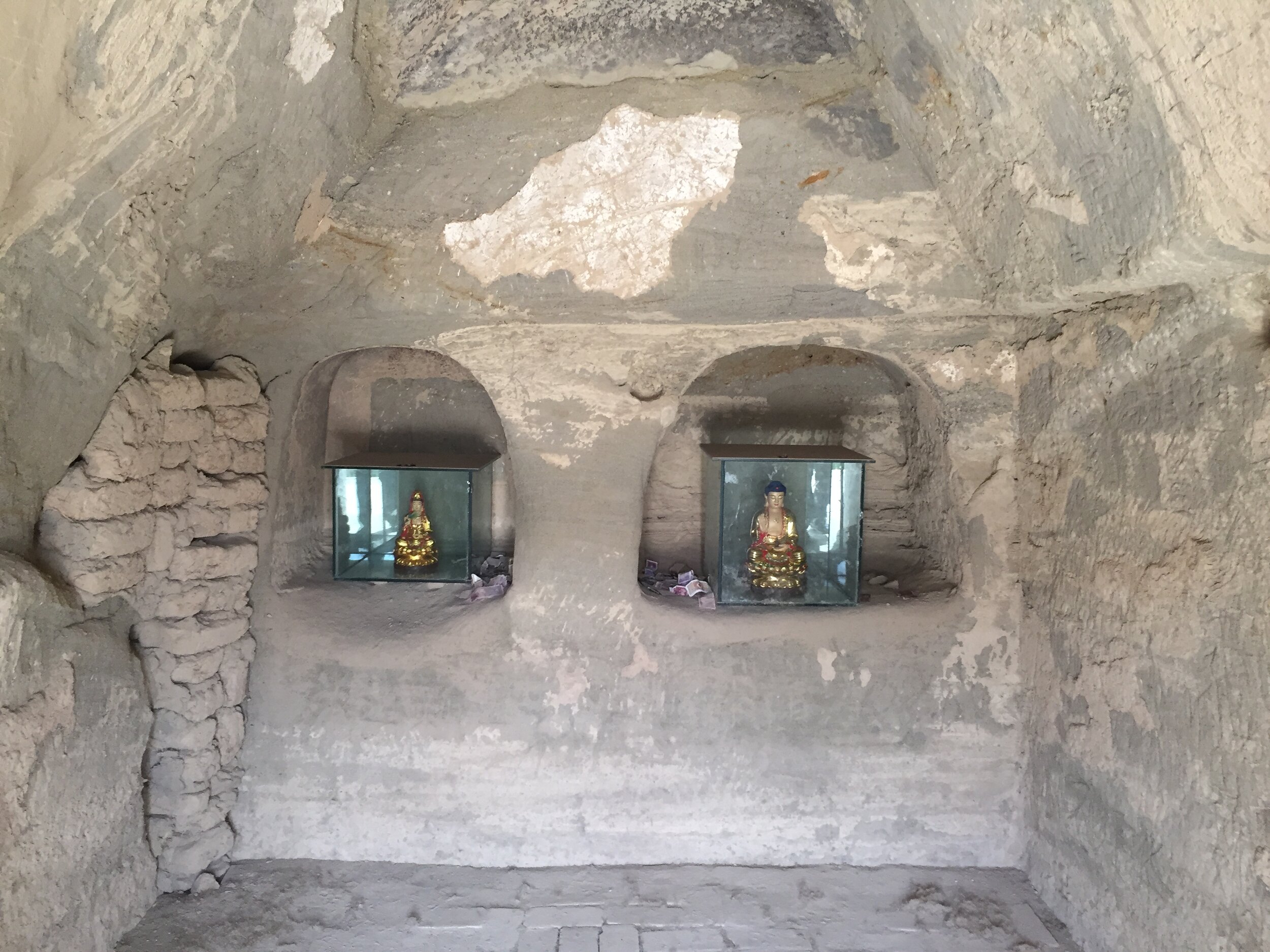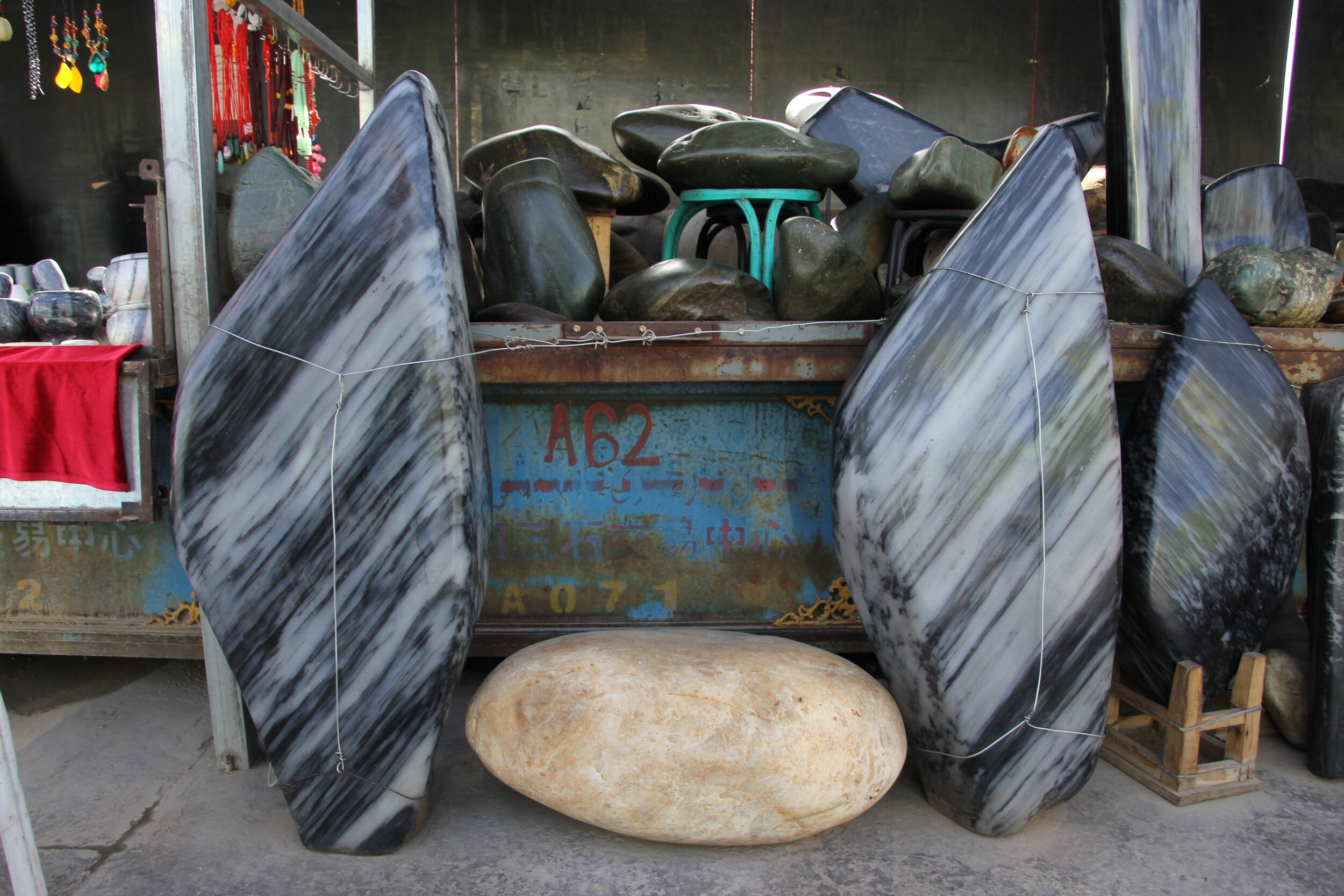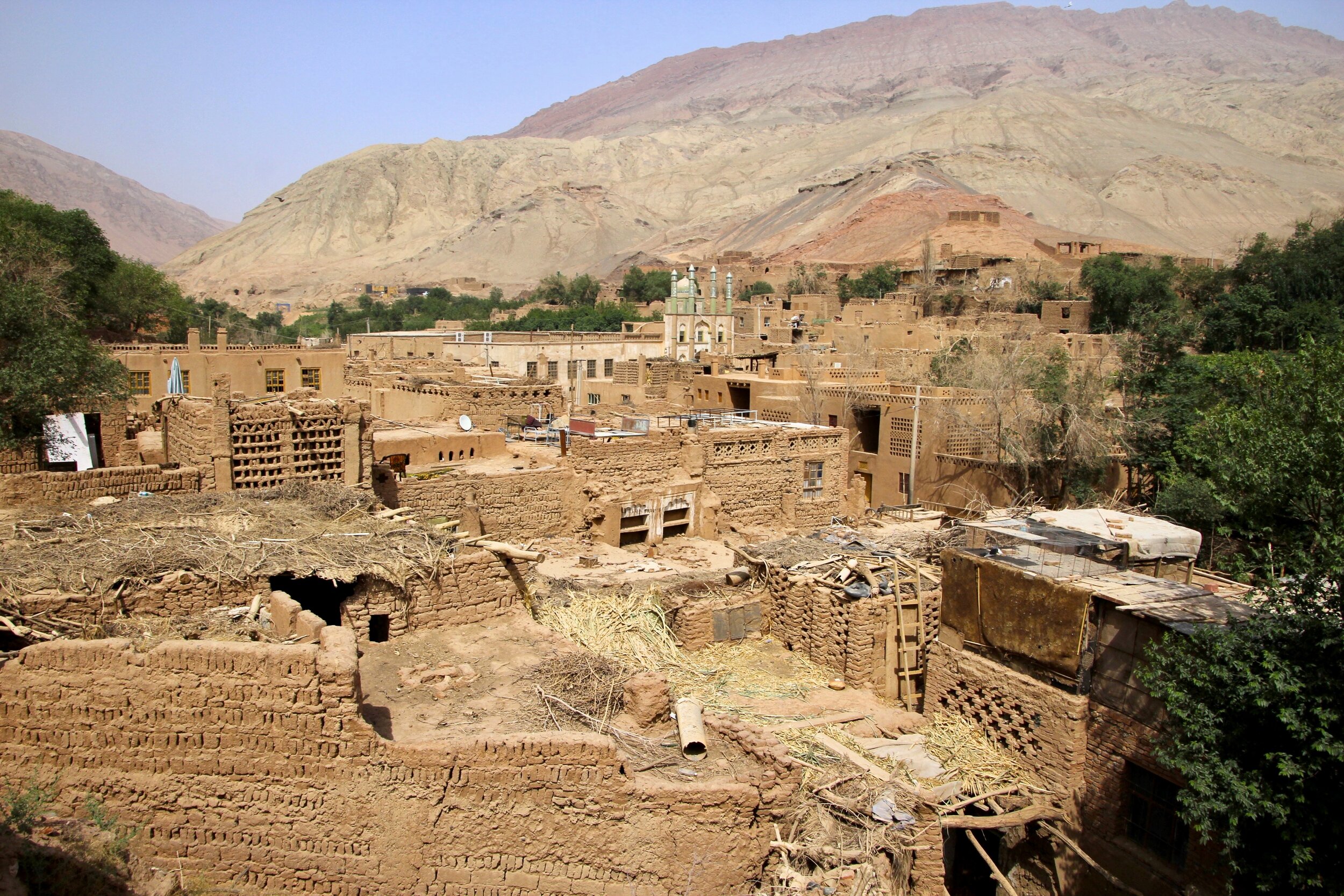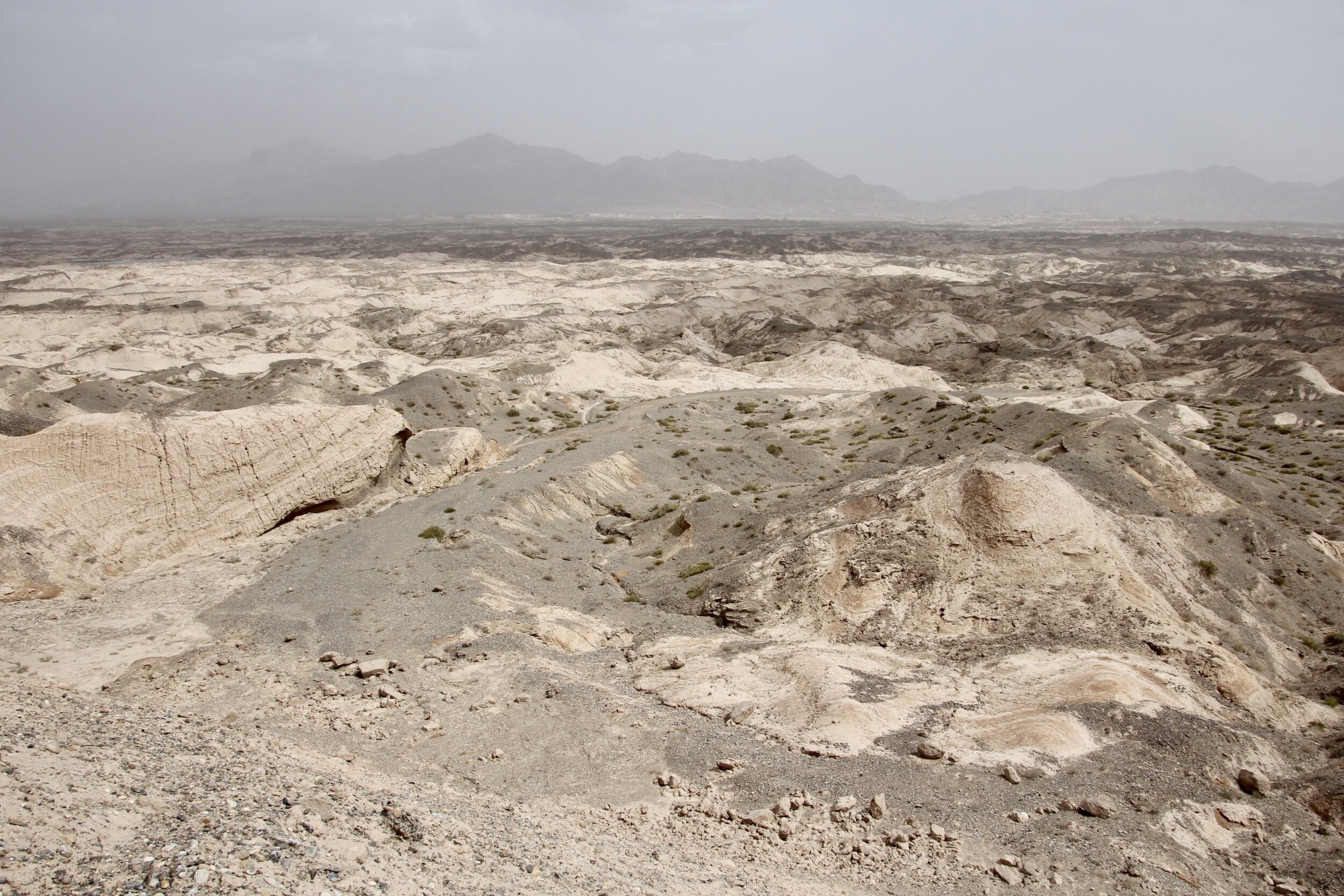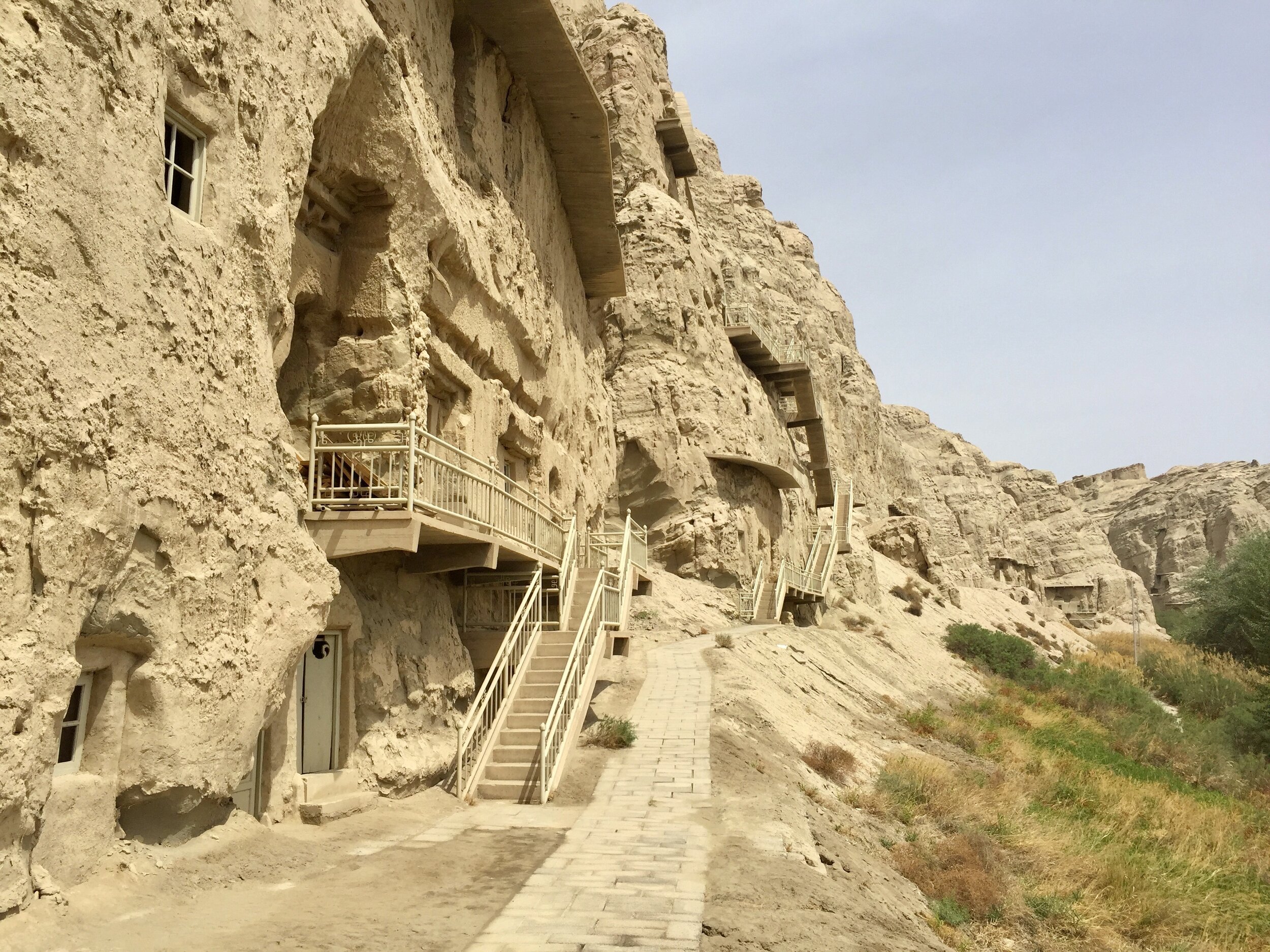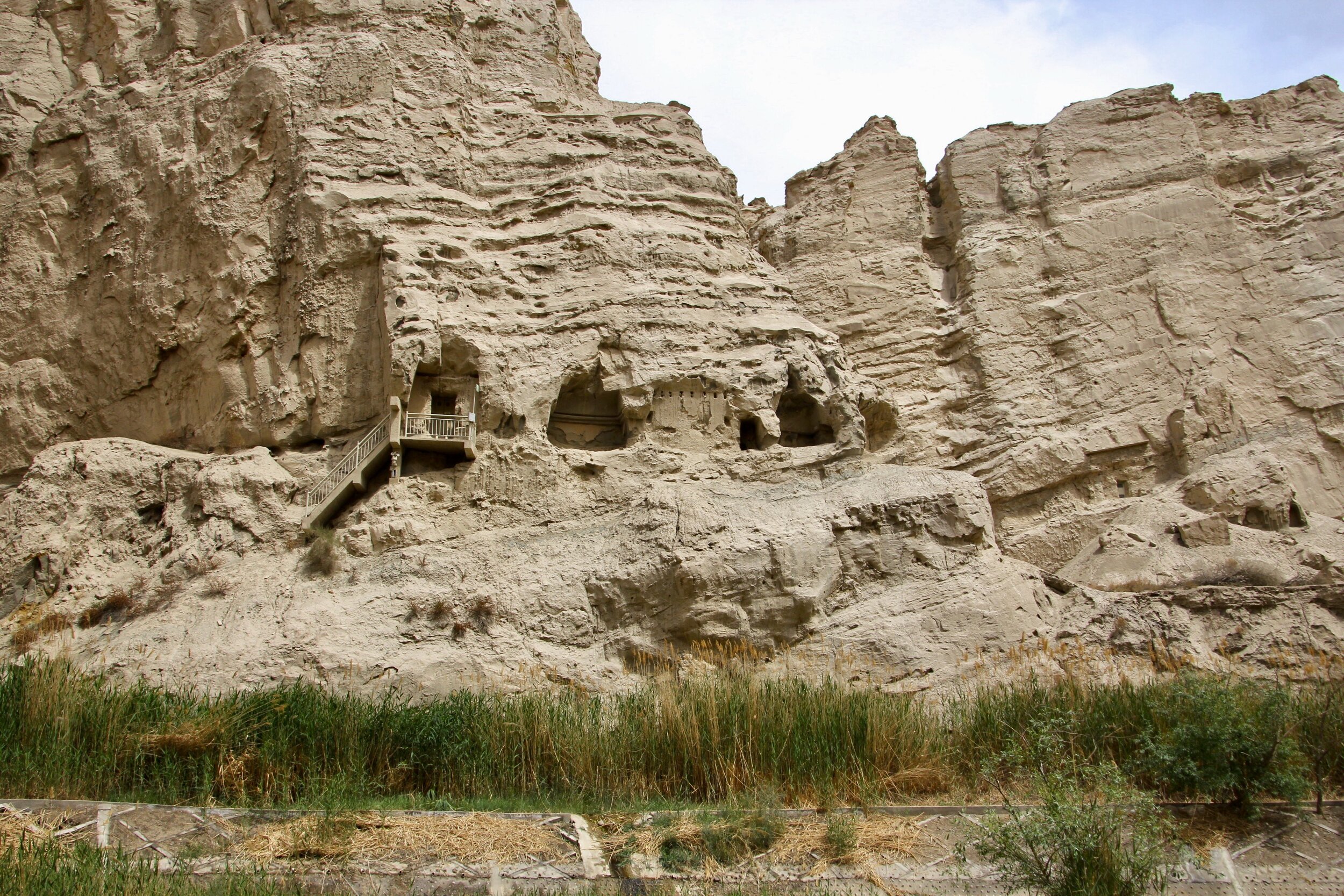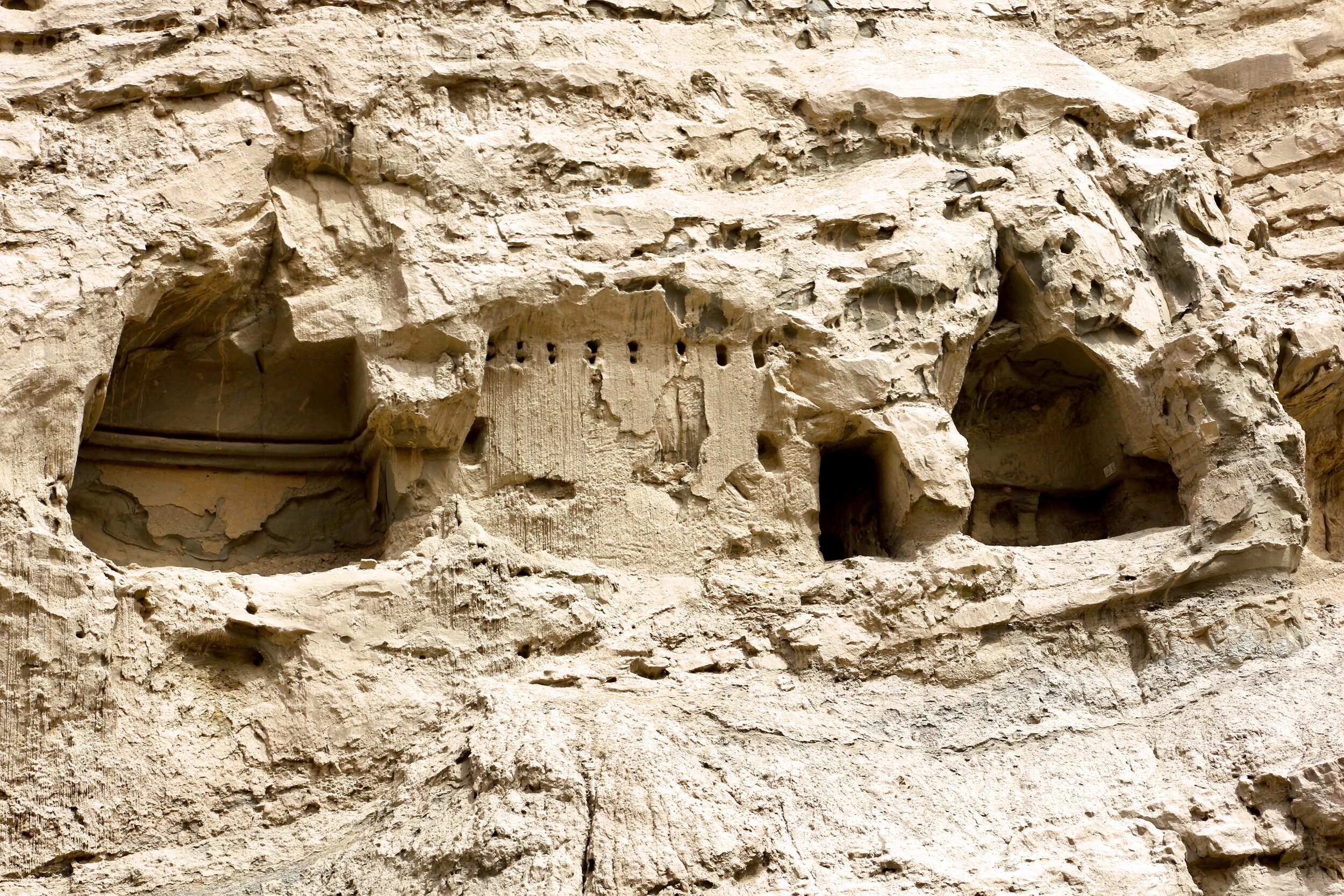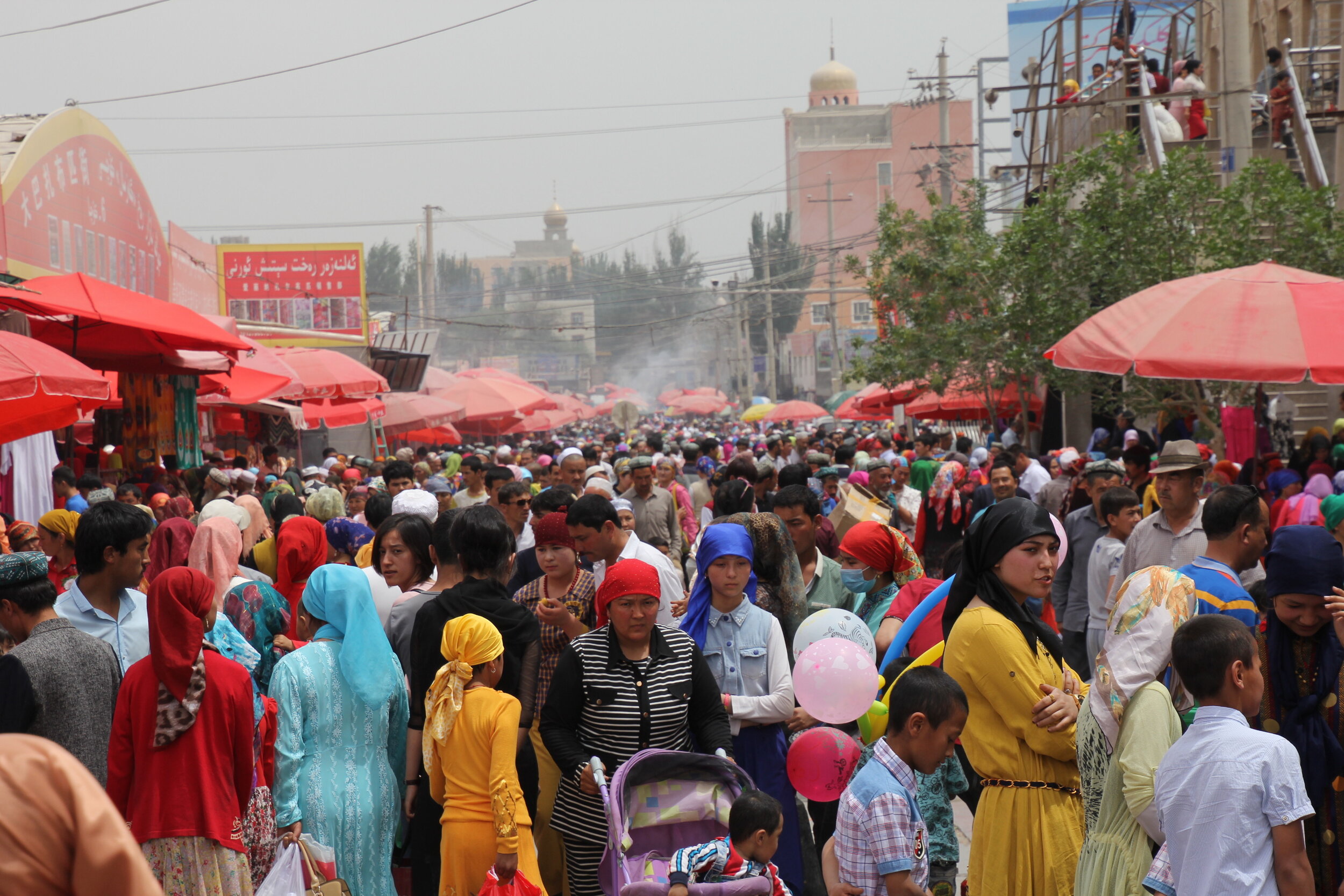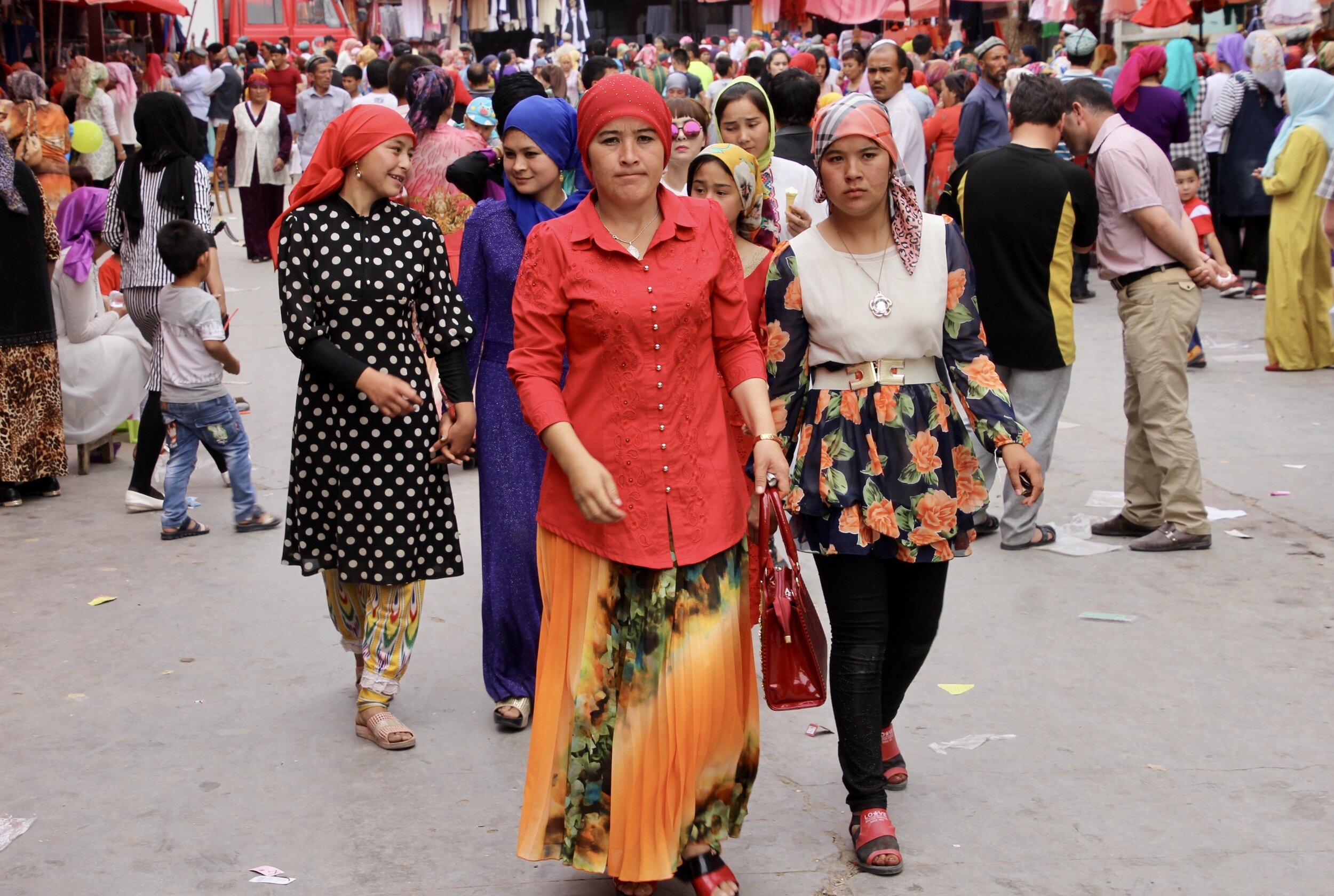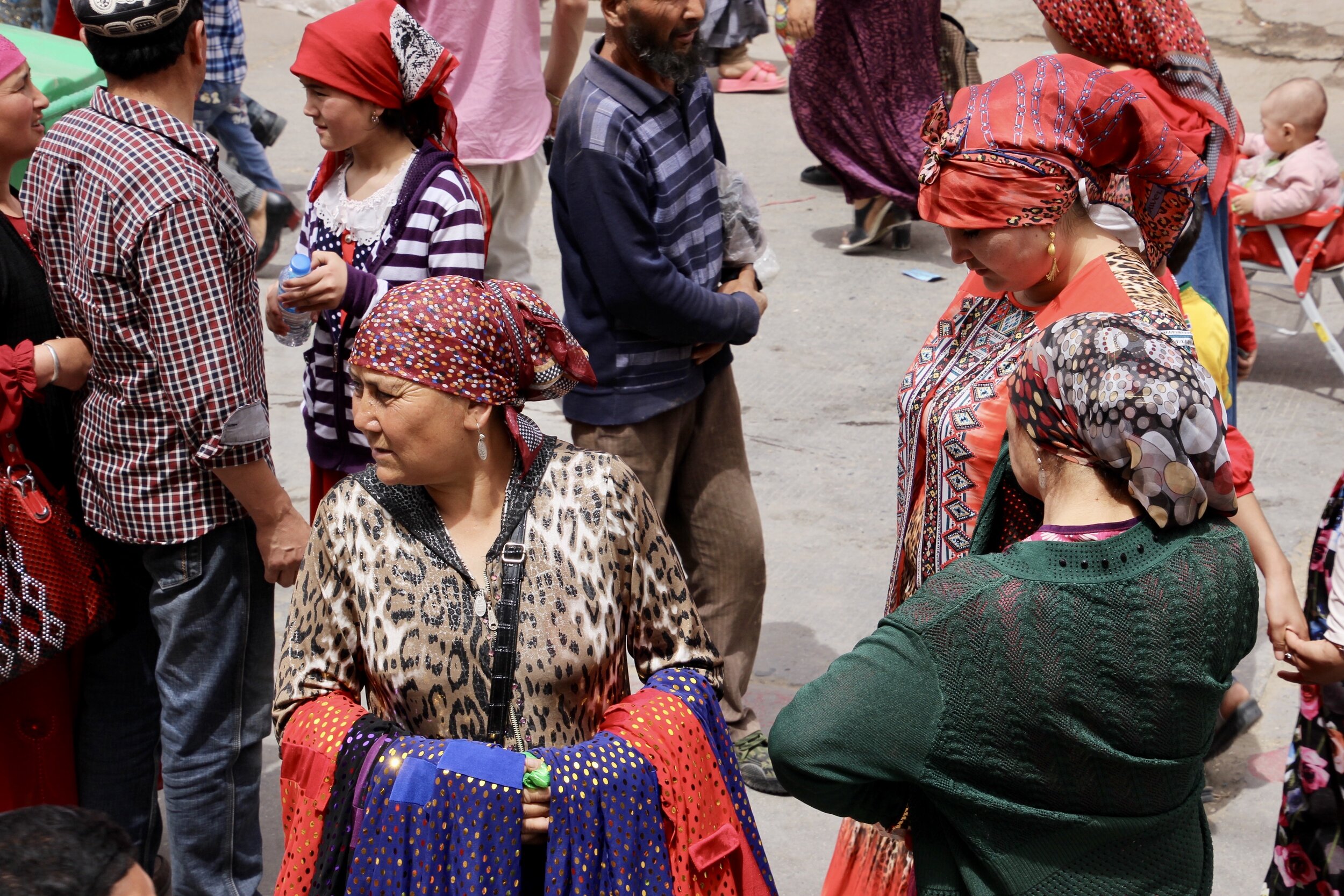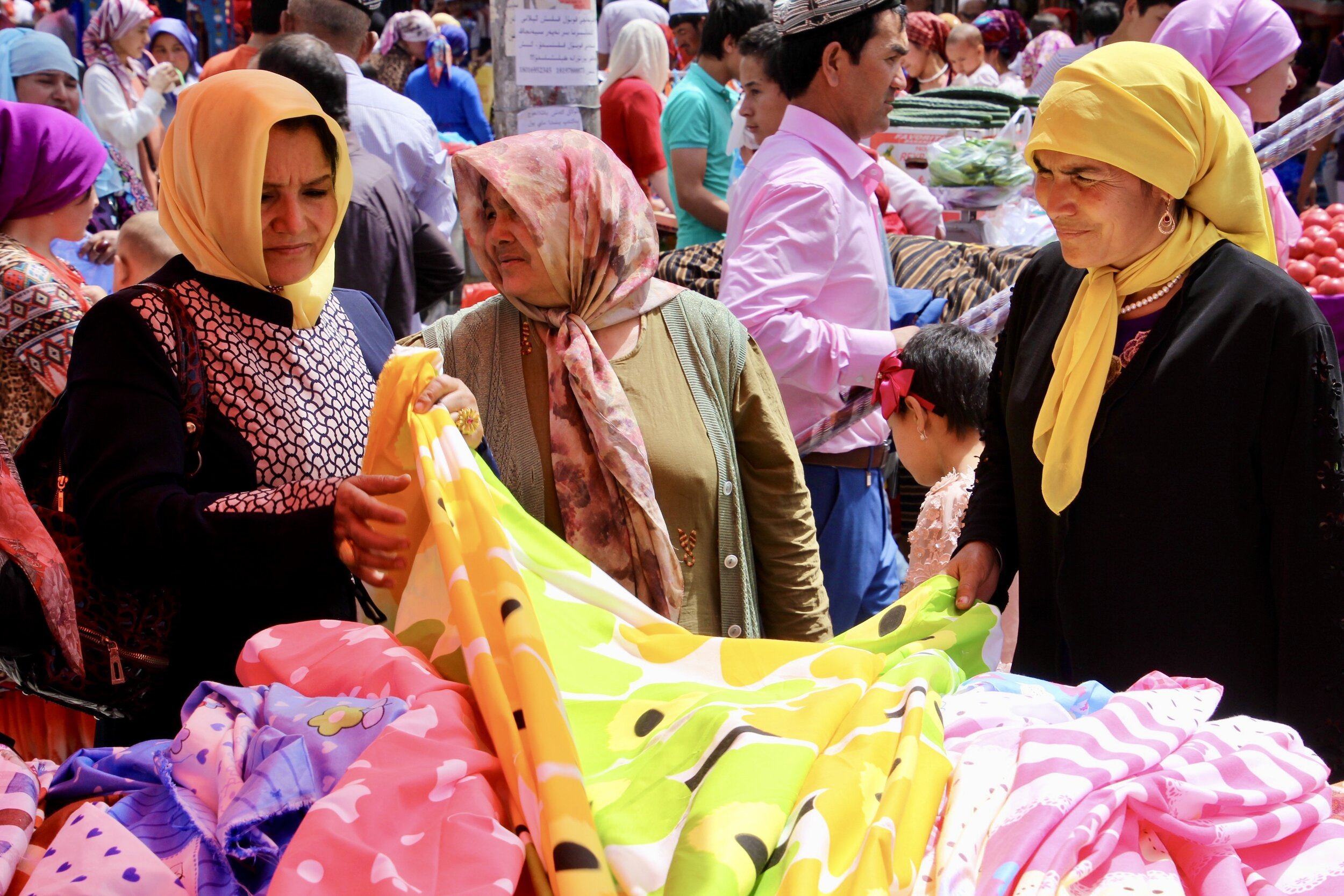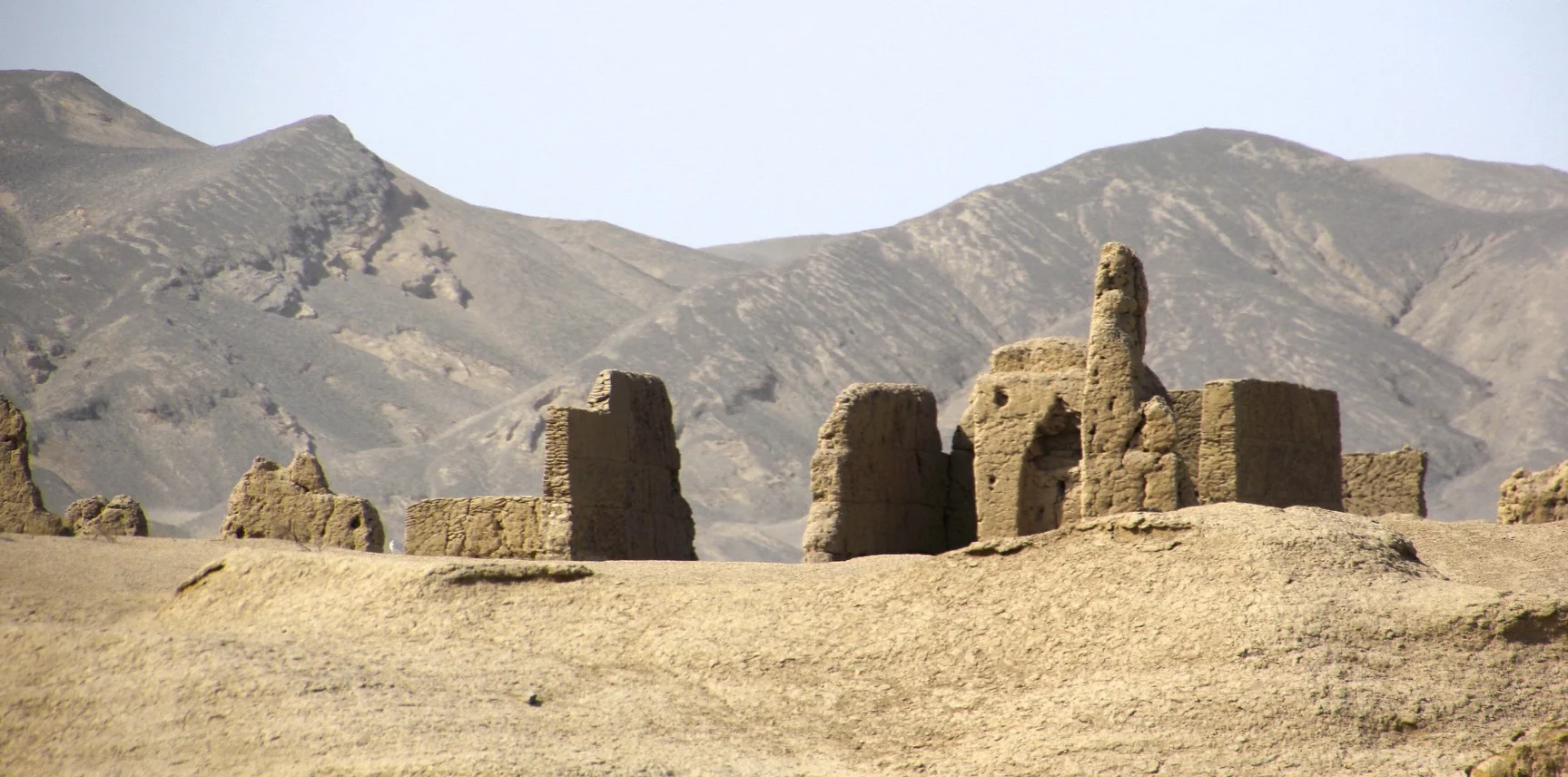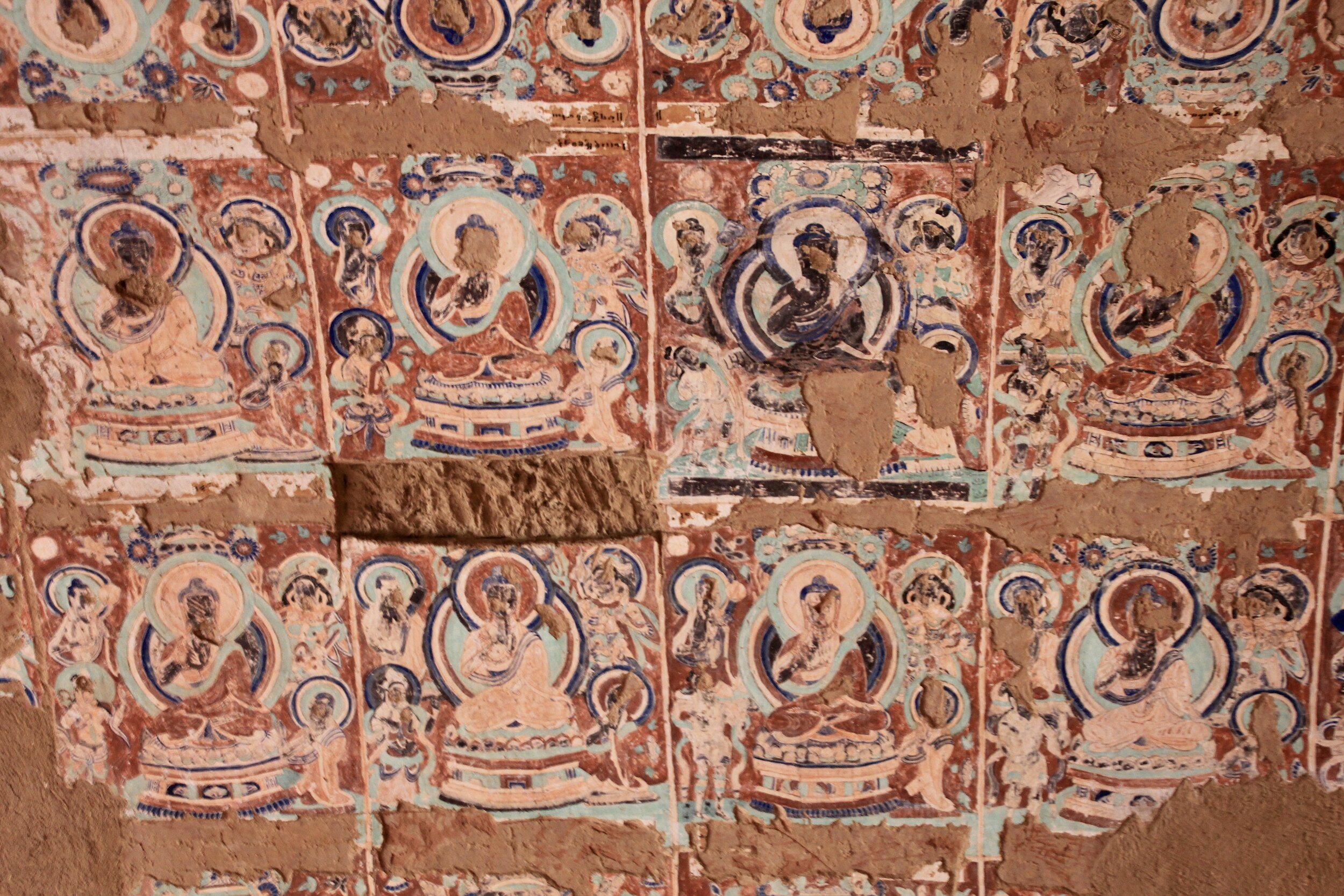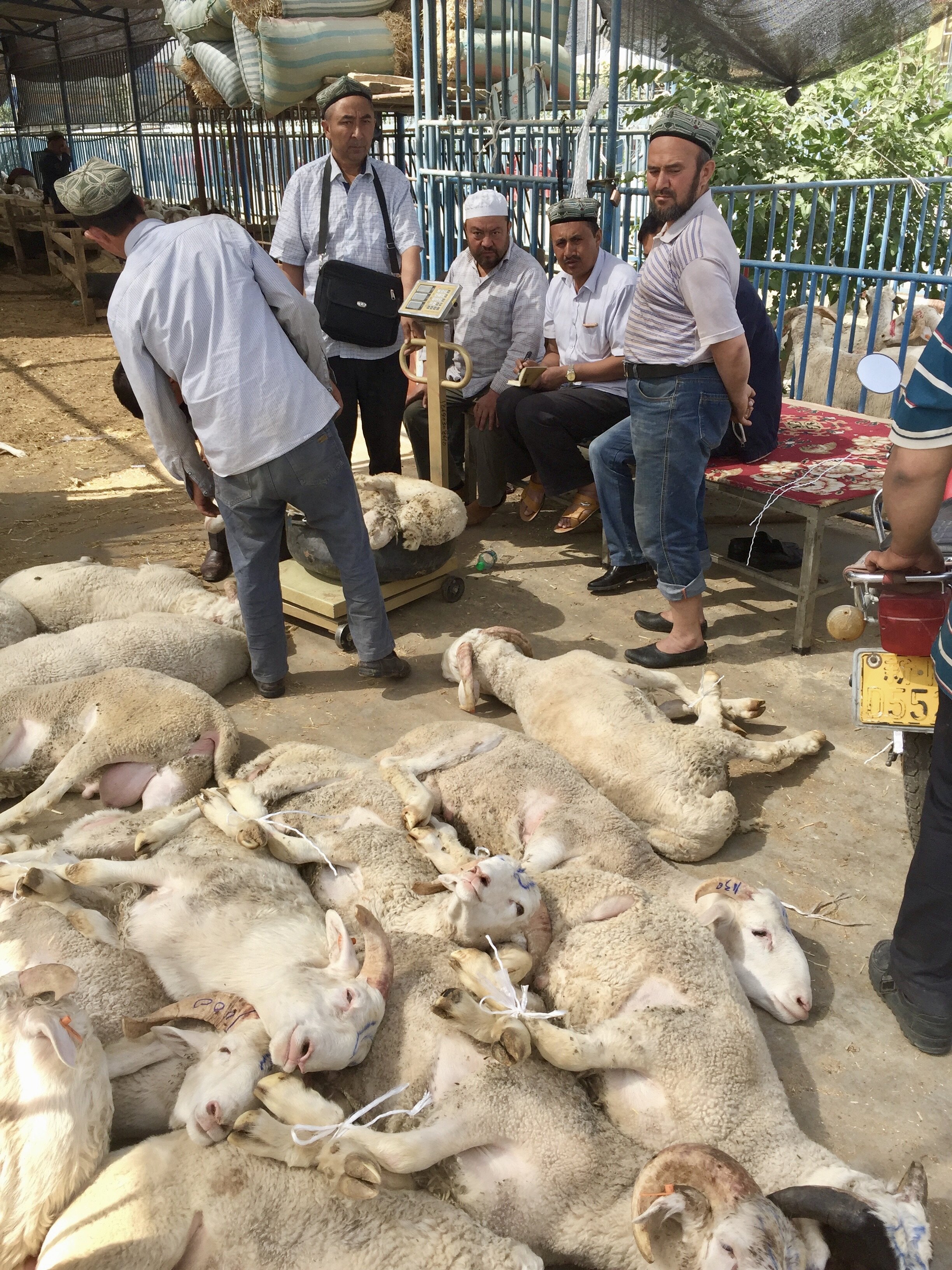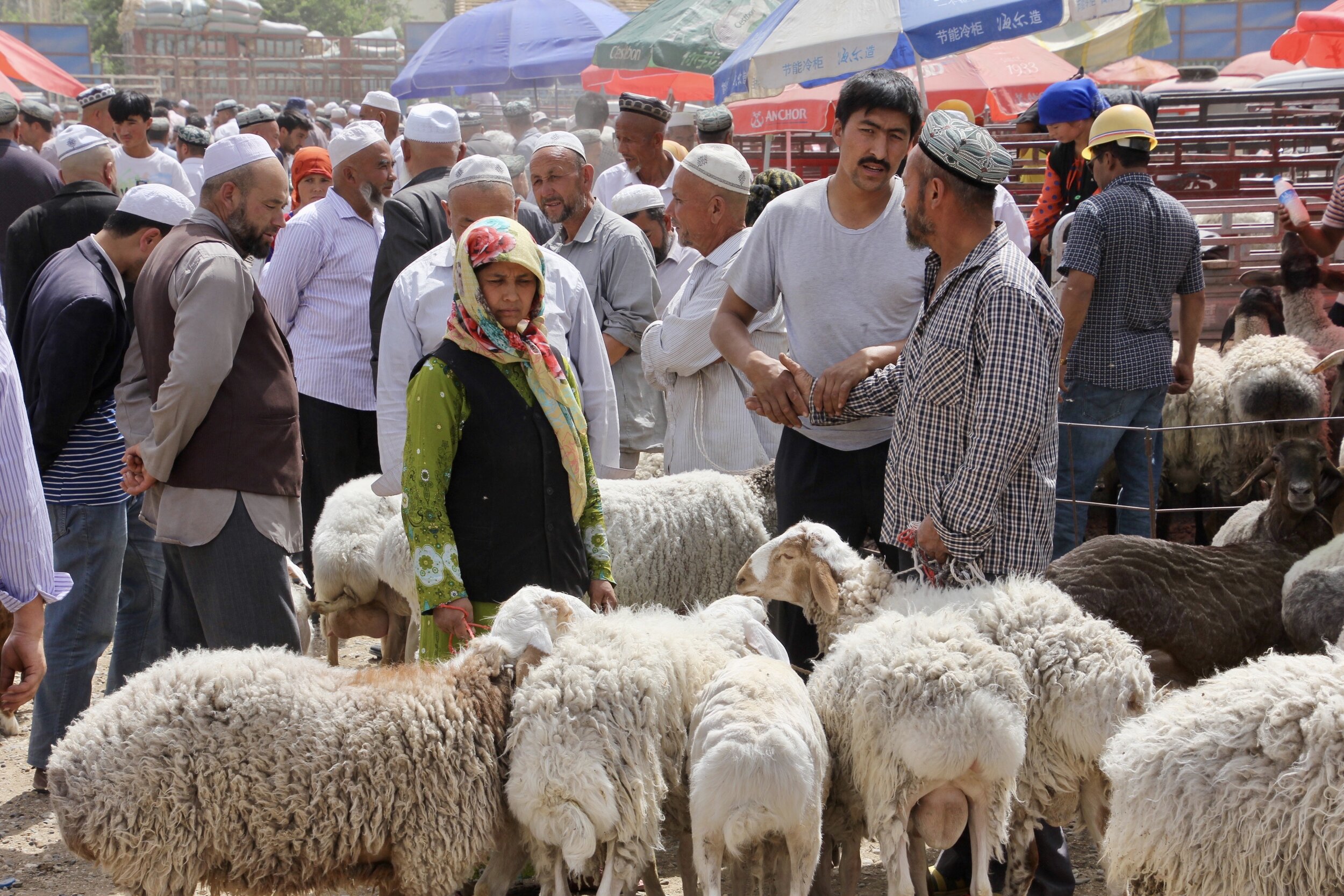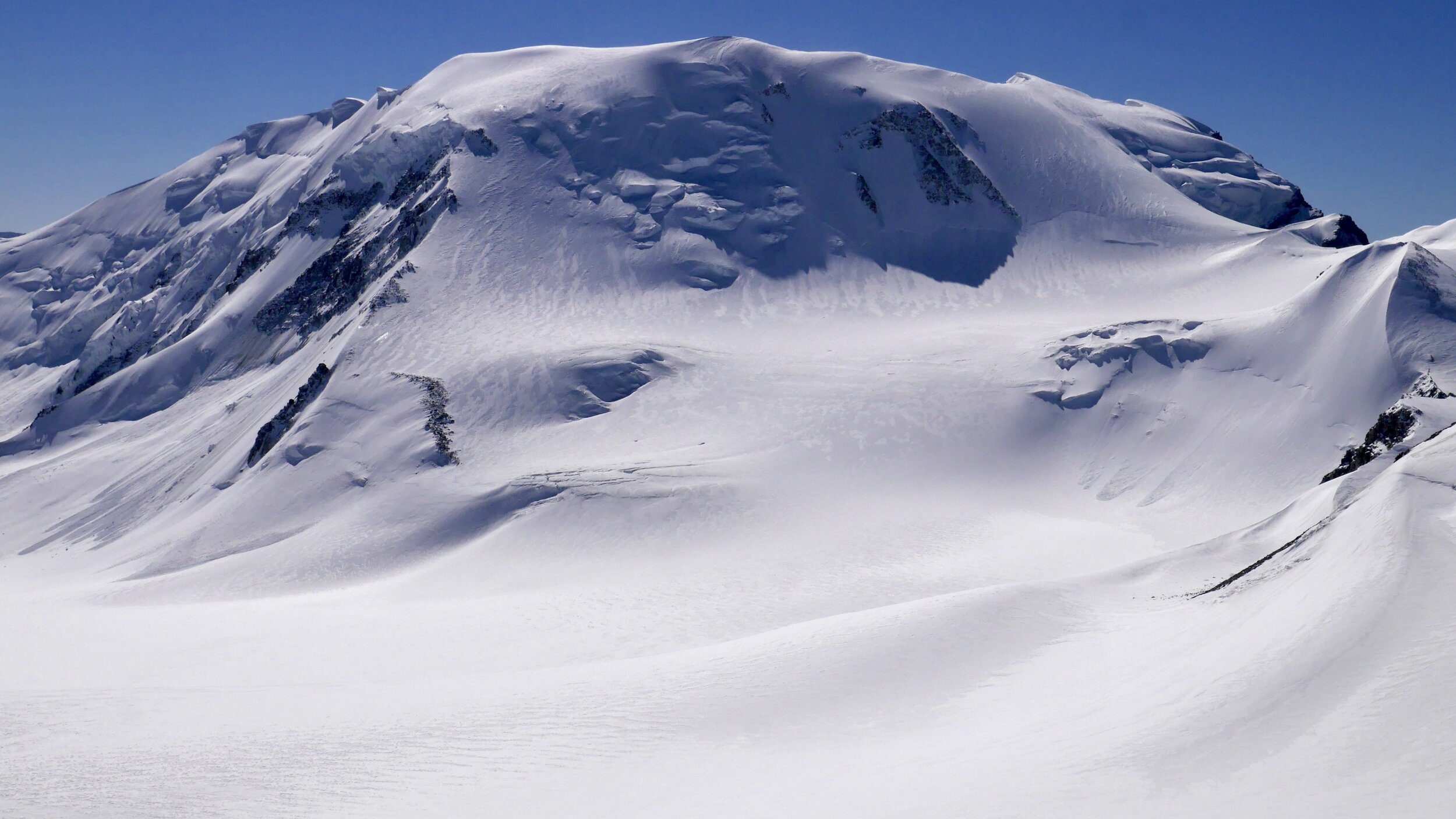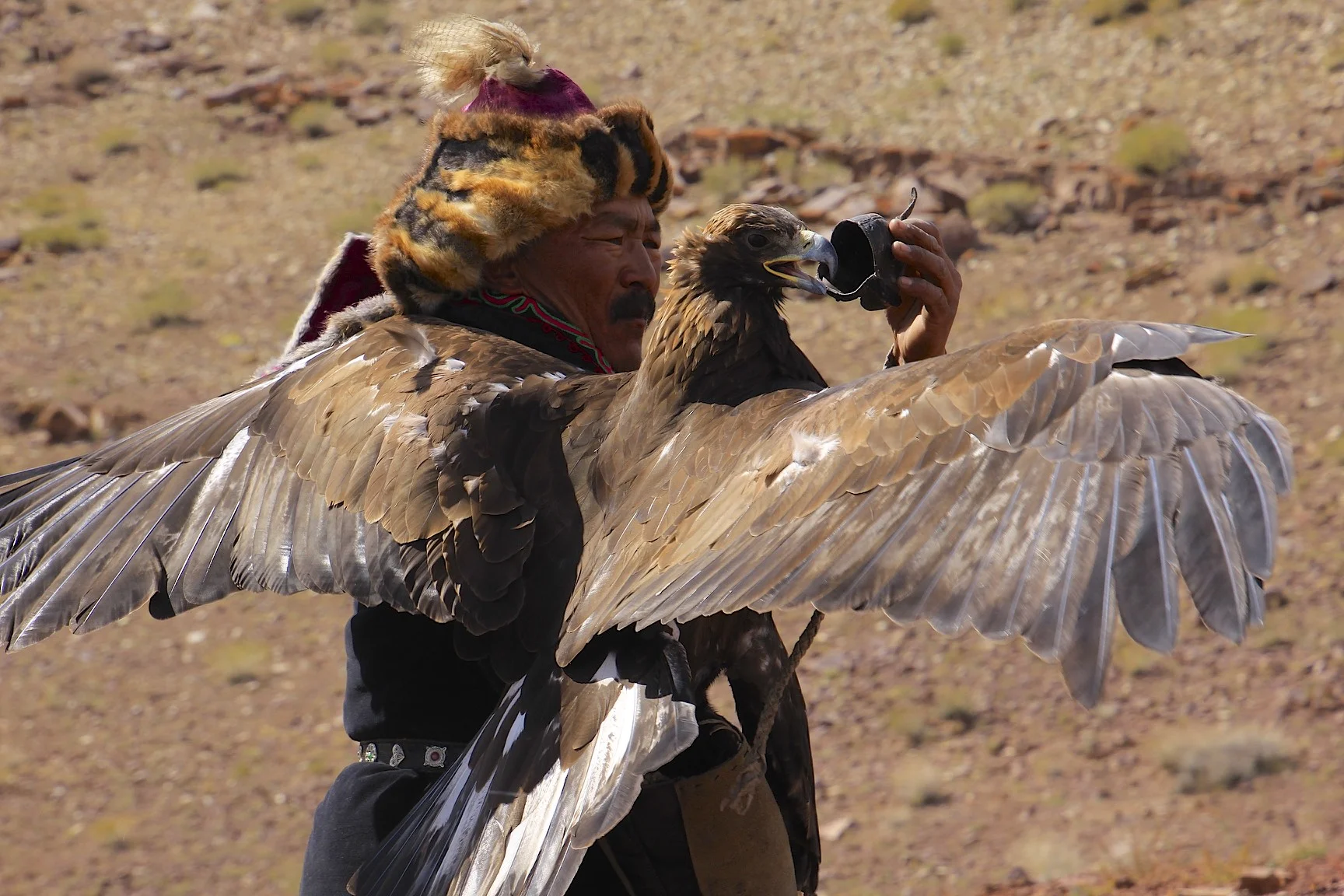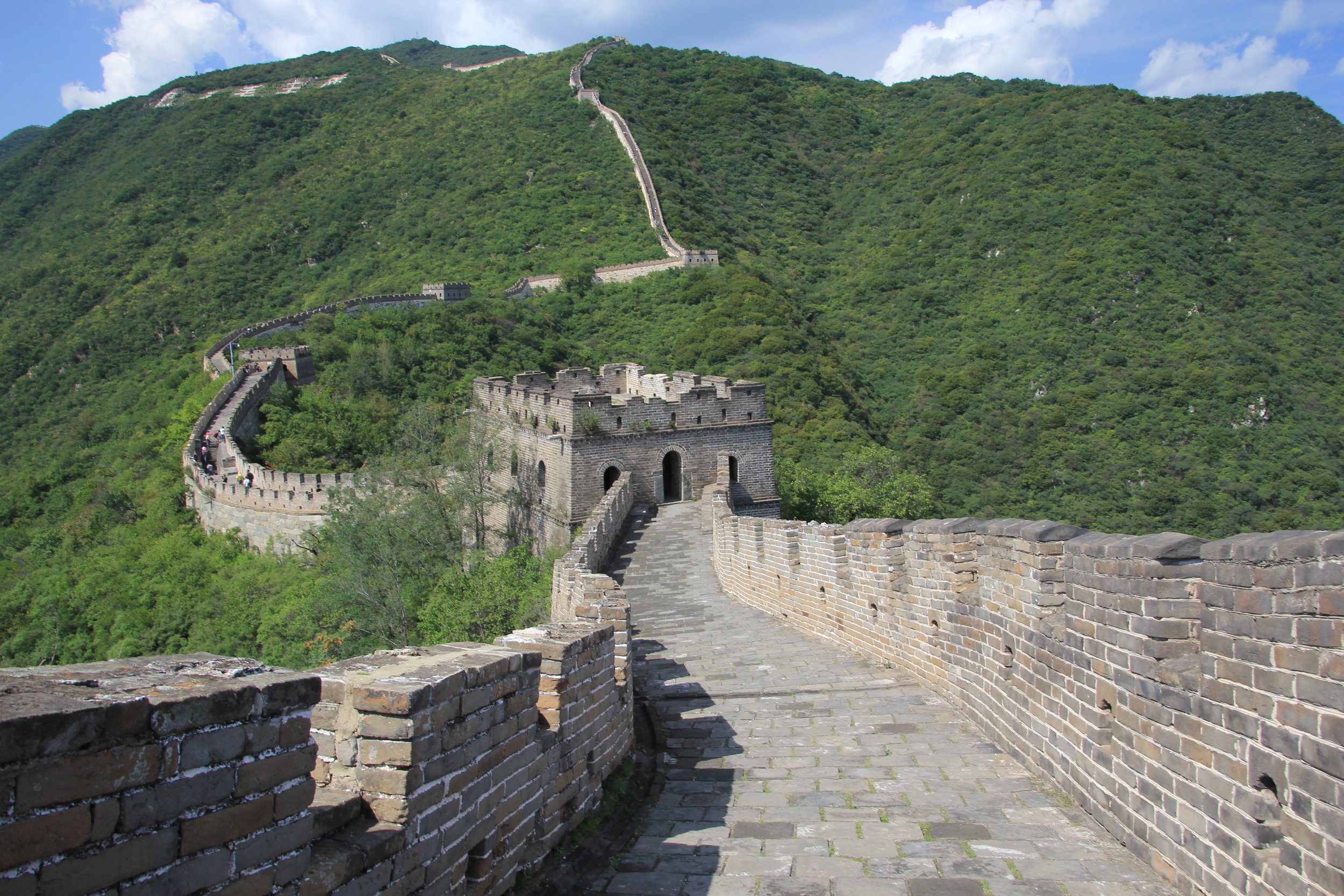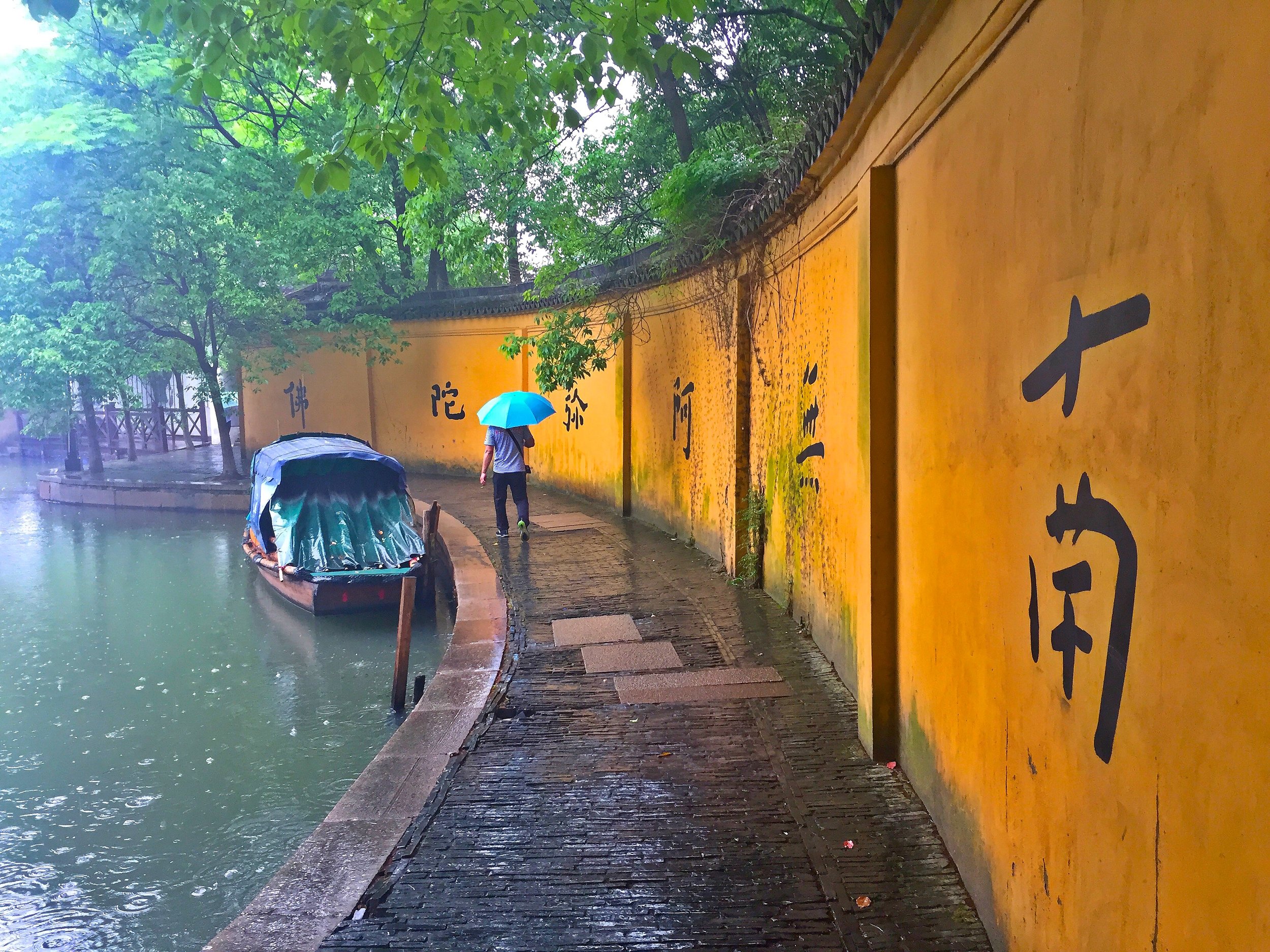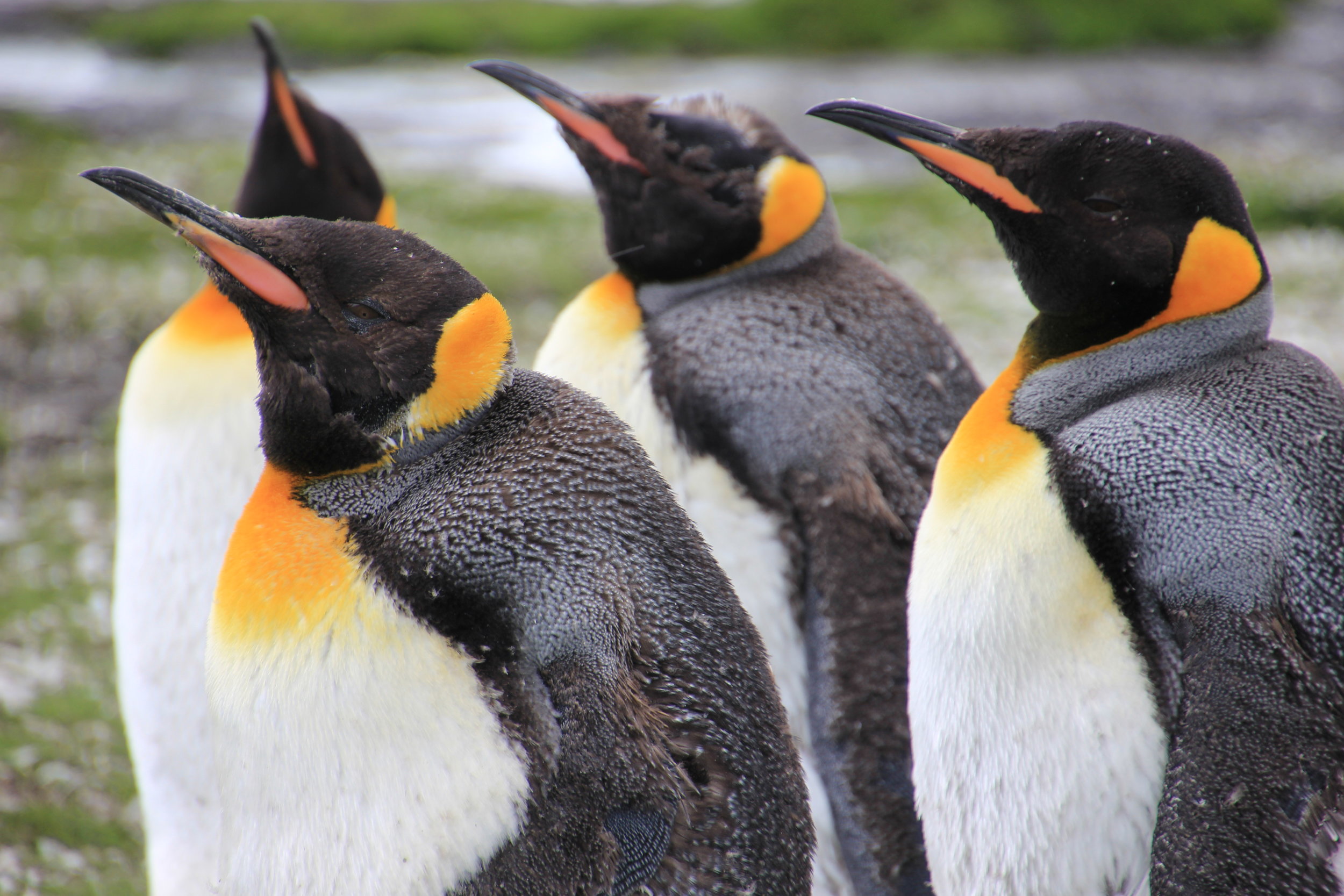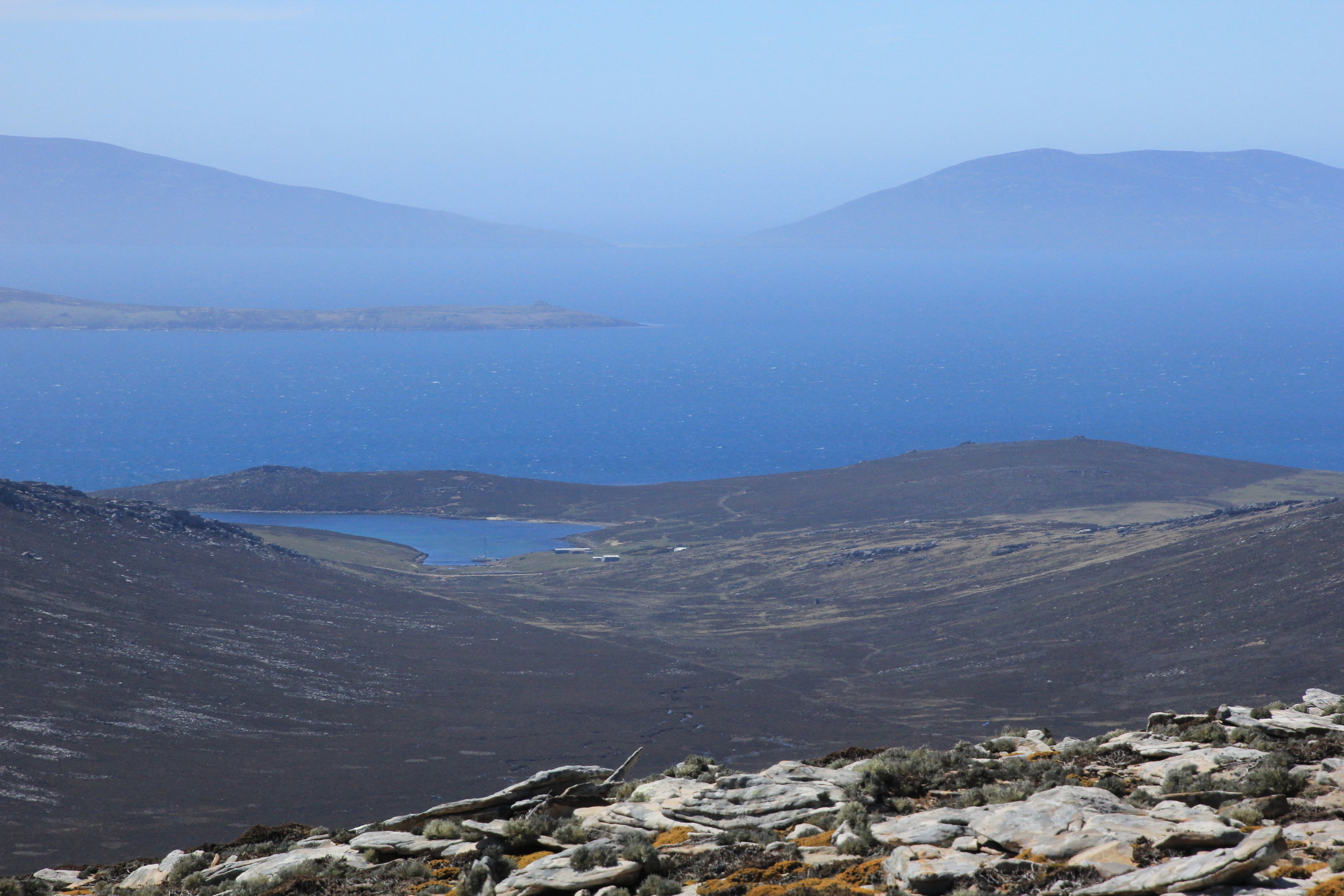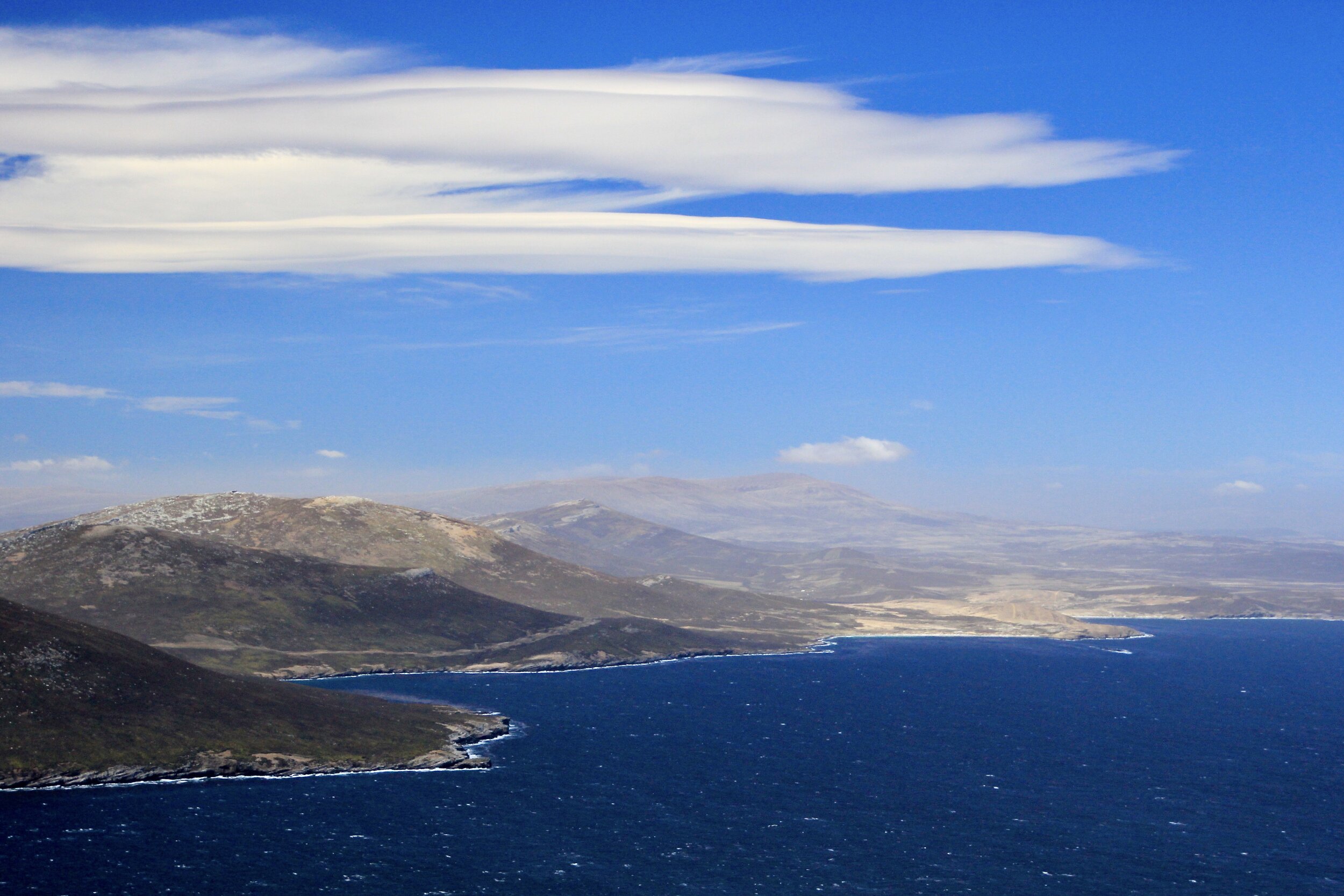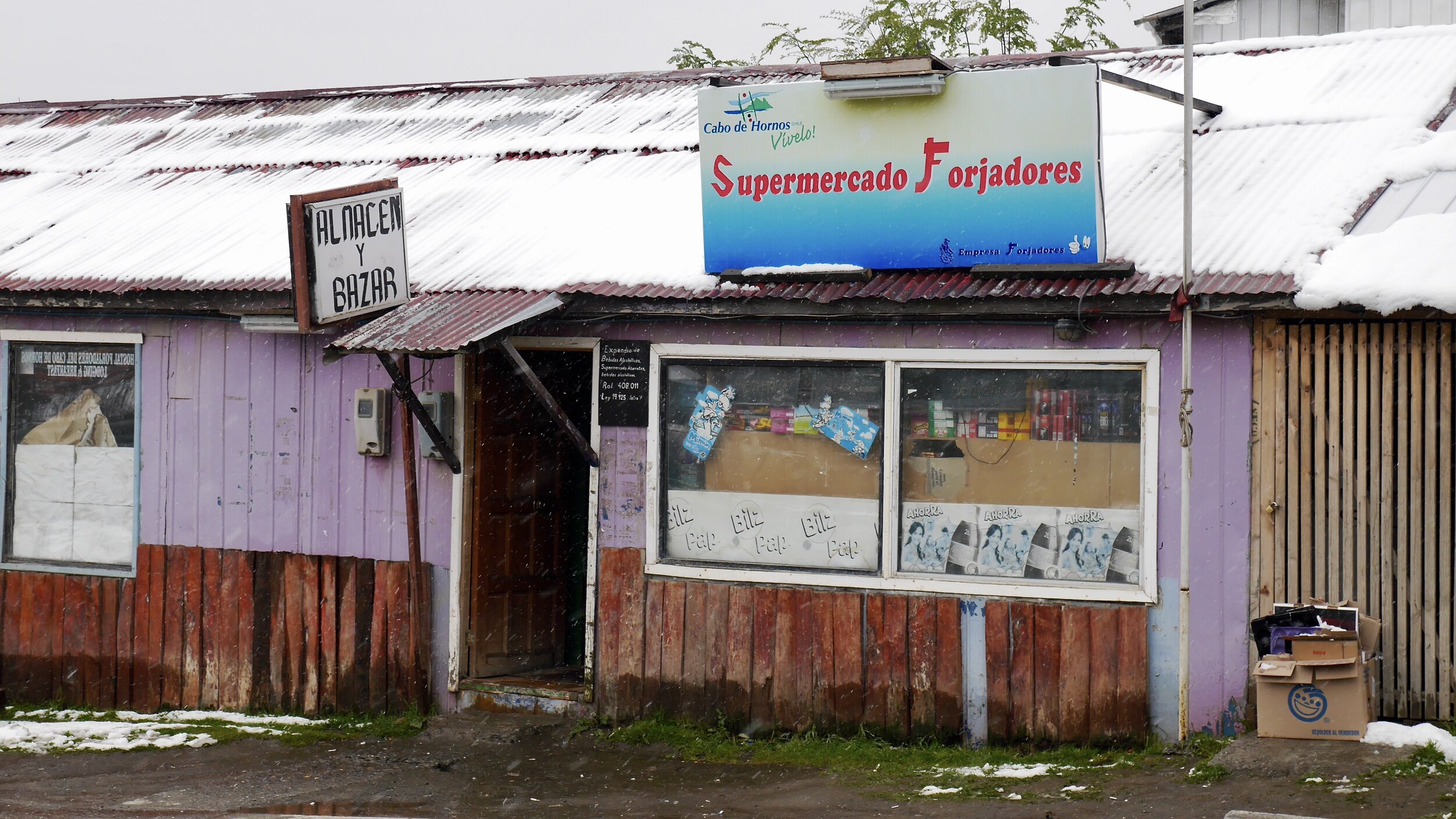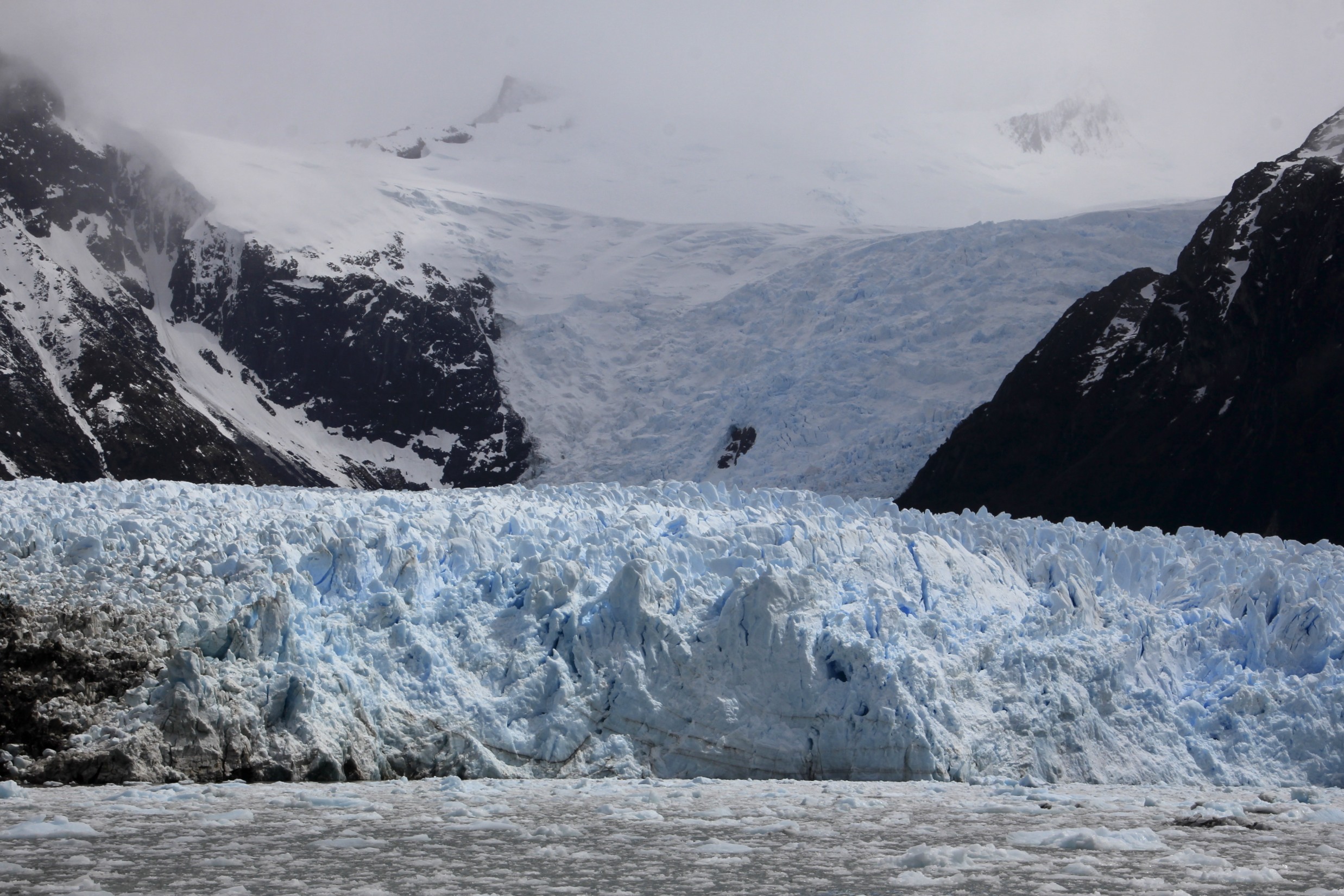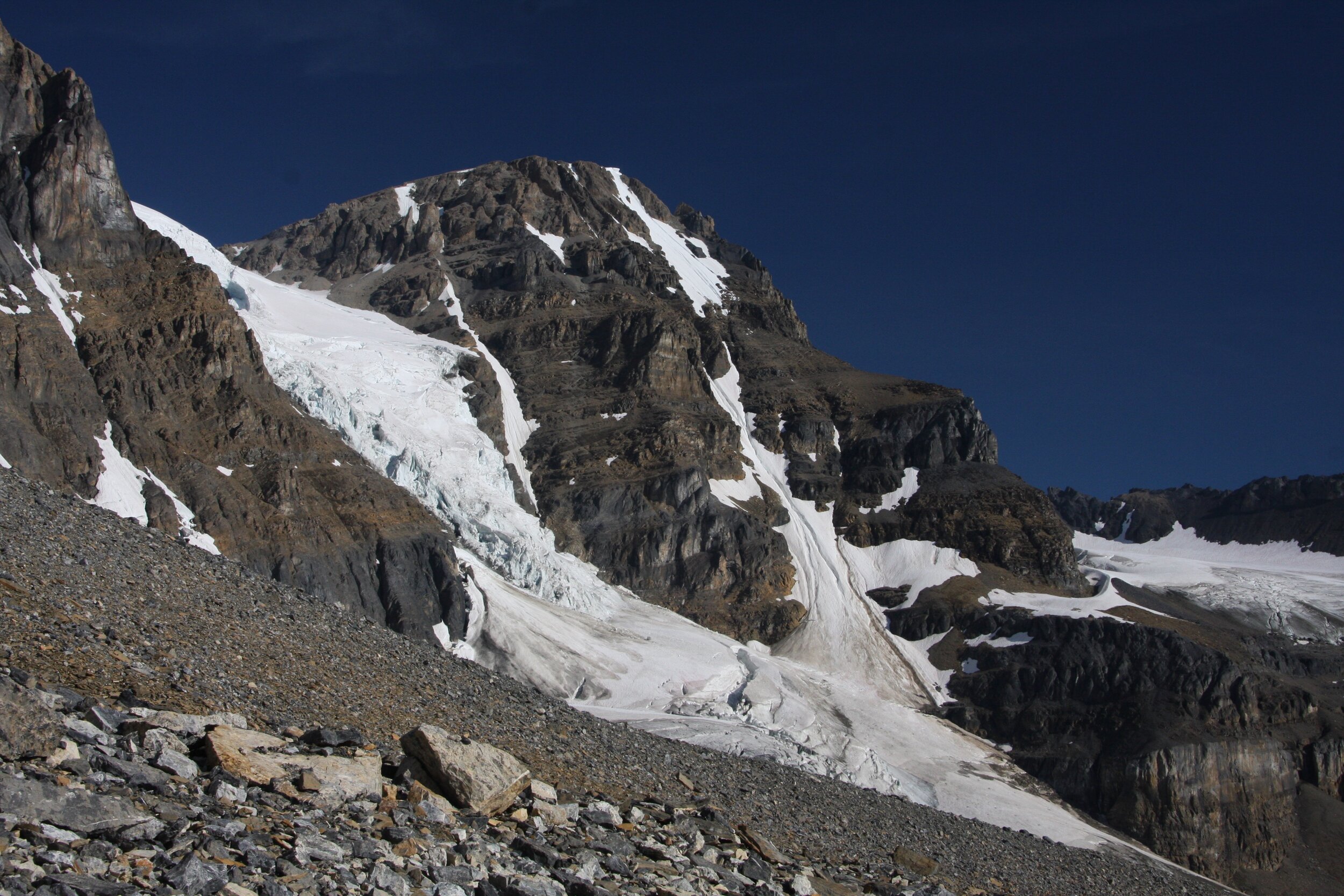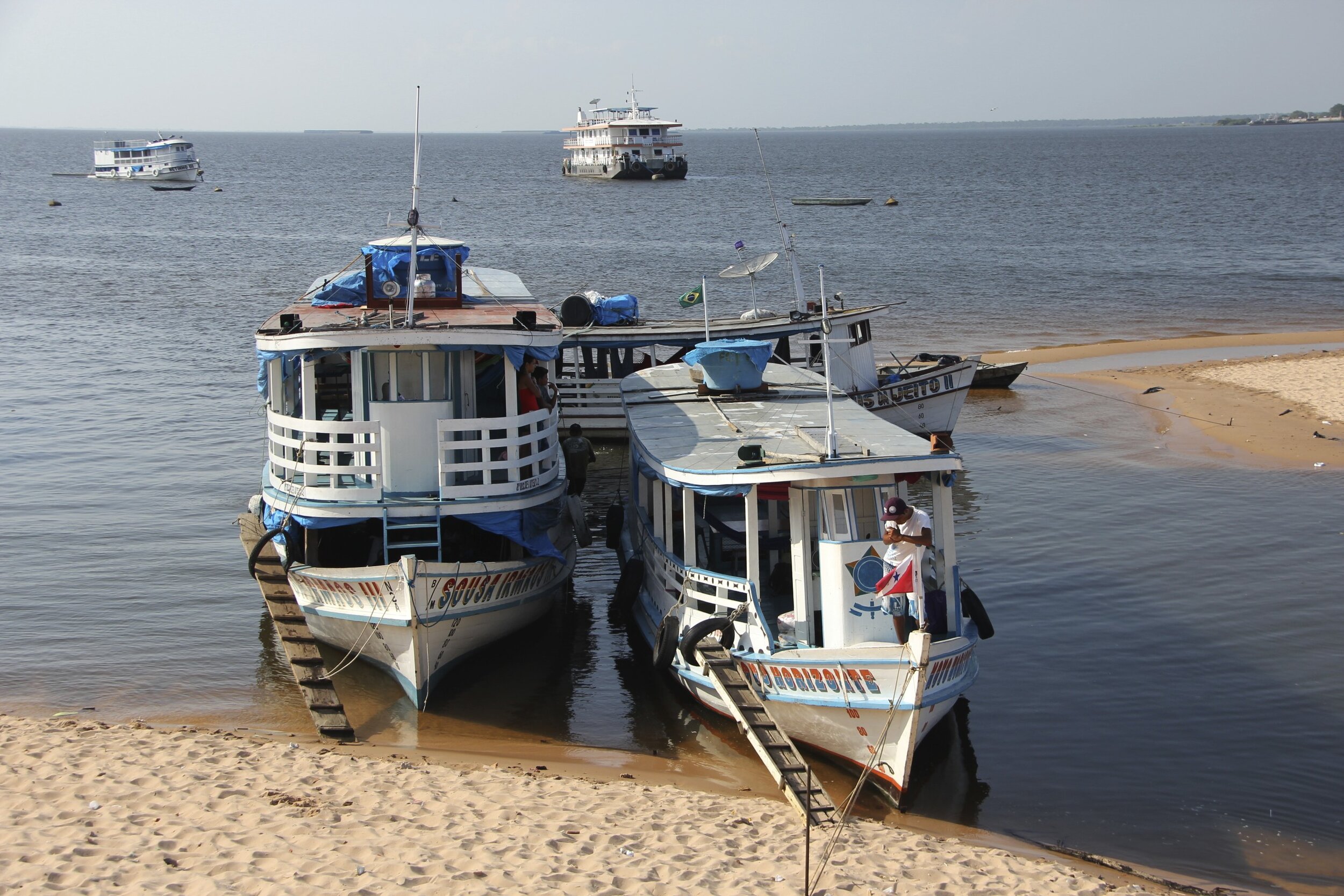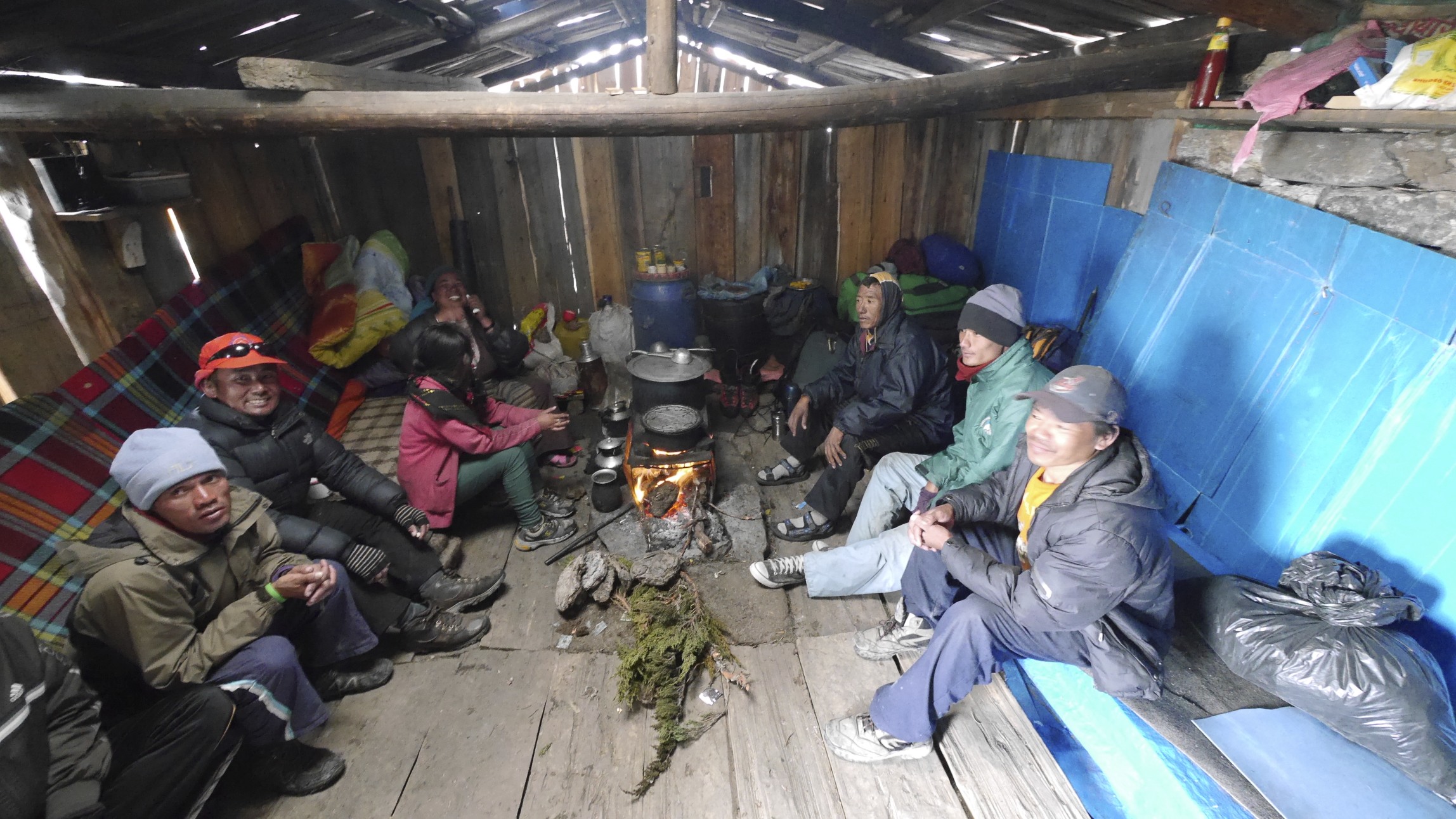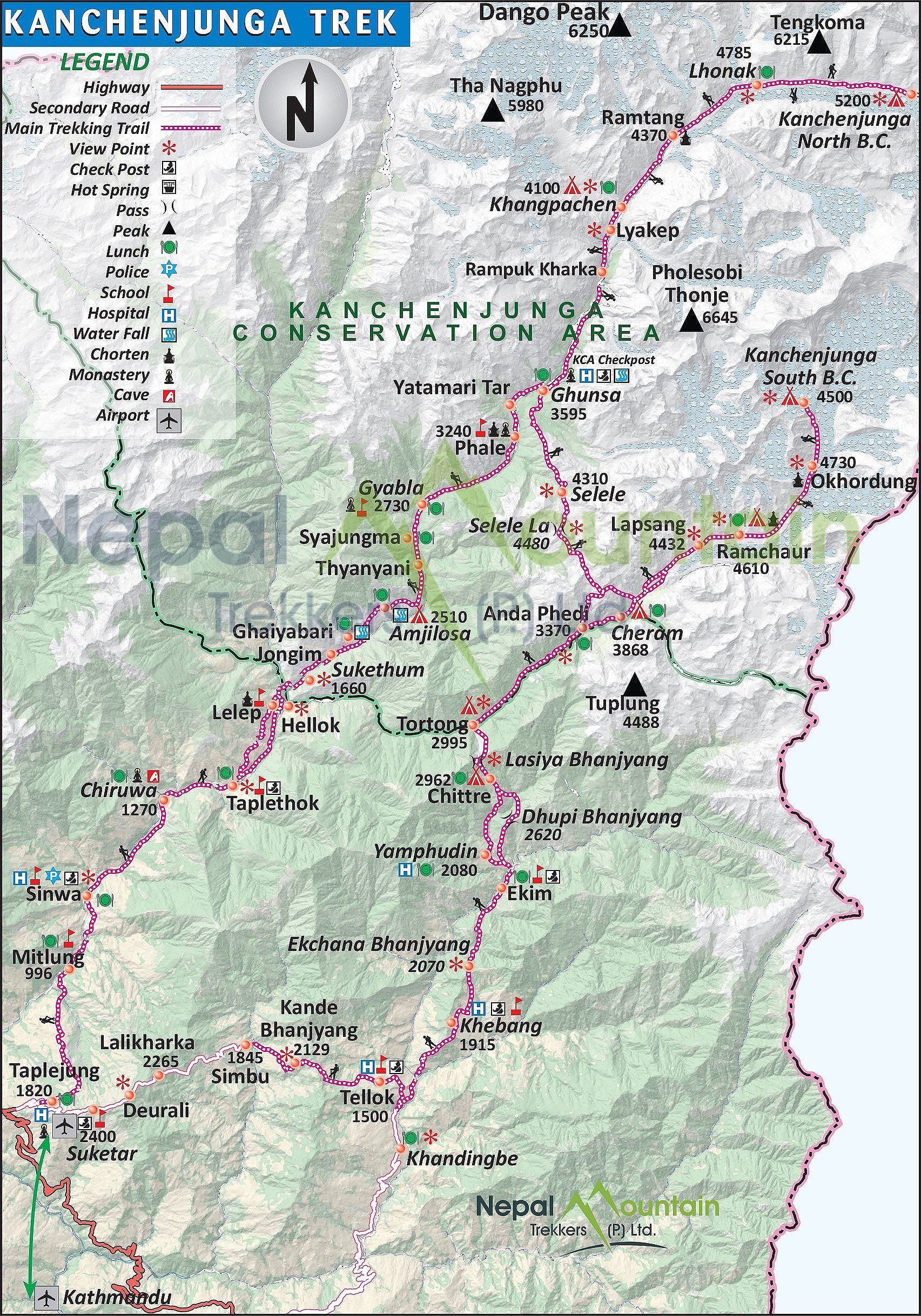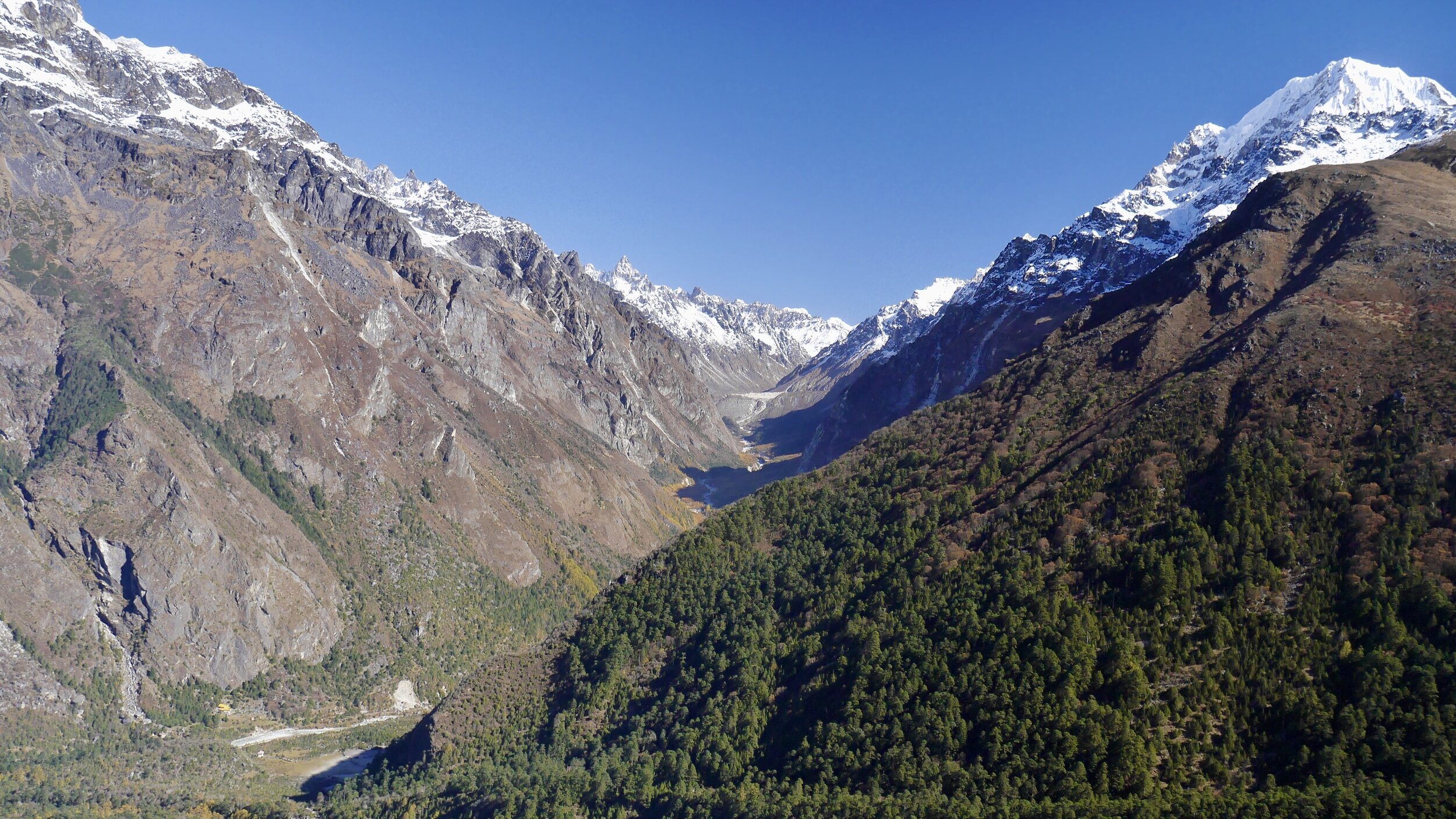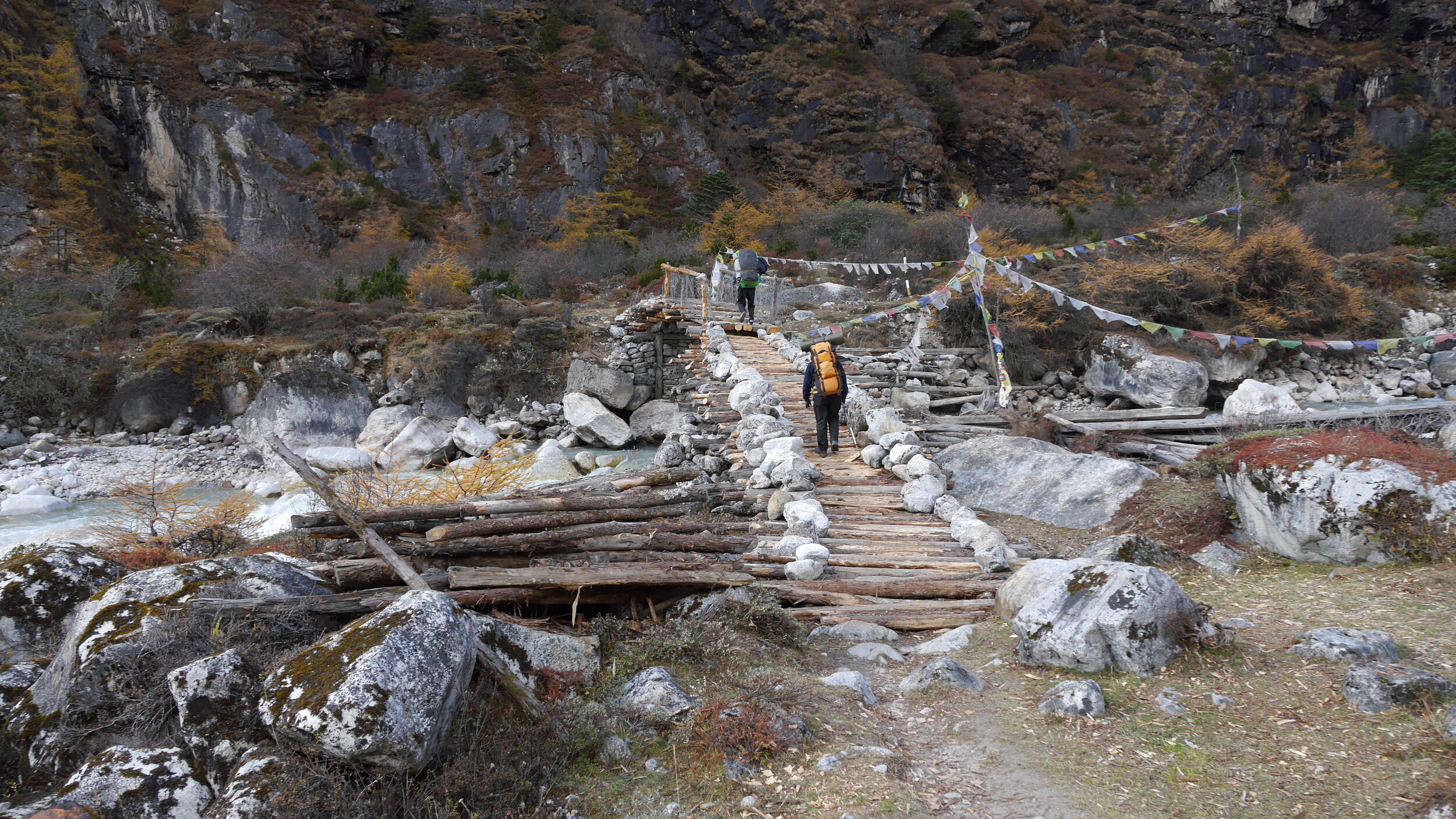My own account of the journey is supplemented with the narrative and useful information from the travelchinaguide (www.travelchinaguide.com) unless otherwise noted.
May 1 - 2, 2016
It is a beautiful sunny day. I am at the airport in Calgary. I am hoping for some beautiful views of the Rocky Mountains on the flight from Calgary to Vancouver. I have a long journey ahead from Calgary to Urumqi via Beijing.
Far East Russia from 35,000ft
During a long flight from Vancouver to Beijing we had beautiful views of northern Russia (probably the Magadan region). It looked like a cold and desolate place with rolling barren hills covered in snow. We finally landed in Beijing after 11 long hours. The passport control and flight transfer were very fast and efficient. I had to wait for 4 hours for the next flight to Urumqi. I was totally exhausted and crashed on the seats at the airport. I was not looking forward to another 4-hour flight. Finally, after a long wait, I got onto the Air China flight as the only white guy. We arrived in Urumqi at 00.30 although the local time was 10.30pm. The air in Urumqi, although cooler, was filled with a distinct small of soot.
On arrival, I met Waheed, our Uighur guide who is also organizing the K2 trip for us in September of the same year. He took me to the hotel where David was already waiting for me. David arrived on Turkish Airlines flight from Istanbul in the morning. Istanbul is only 5 hours away (almost as far as Beijing!). Our centrally located hotel was very gaudy and tasteless in décor but very comfortable and provided me with a welcome rest considering how tired I was.
At first glance, Urumqi seemed like any other huge Chinese city. It was full of concrete buildings and highways with little regards for beauty. The city has 5 million inhabitants. While driving around on the elevated expressways, we saw a forest of apartment buildings and office towers. Apparently, this city is a hub of trade with all the Stans of Central Asia and part of the new Silk Road.
May 3, 2016 Urumqi – Turpan
We got up quite early and went for breakfast. The breakfast food was somewhat unusual: steamed buns with mutton and steamed buns with dates and raisins. It was actually very good, not the usual eggs and bacon or the Chinese buffet. After the breakfast David and I went for a quick walking tour of the city near the main bazar and the hotel. The part of the city that we were walking in had a very different feel to it. The restaurants were serving the traditional foods with kebab grills outside. The architecture was different too with more central Asian accents and design. Since it was quite early in the morning, nothing was open so we decided to return to the hotel and meet Waheed.
From the hotel, we drove to the Provincial Museum to see the main attraction: the Tarim mummies. The museum was excellent, clean and very interesting. The main attraction were the Tarim mummies. I read a book about these mummies and saw many photos of them over the years. The display in real life had all the mummies from the book I read. The museum had many displays in English although not all. The mummies are shrouded in mystery. They are very old and the origin of the people whose graves were discovered is unknown and subject to much speculation. An analysis of their clothing revealed that the possible origin is somewhere in central or northern Europe.
The Provincial Museum
“One glimpse of the corpses was enough to shock Victor Mair profoundly. In 1987, Mair, a professor of Chinese at the University of Pennsylvania, was leading a tour group through a museum in the Chinese city of Ürümqi, in the central Asian province of Xinjiang, when he accidentally strayed into a gloomy, newly opened room. There, under glass, lay the recently discovered corpses of a family--a man, a woman, and a child of two or three--each clad in long, dark purple woolen garments and felt boots. "Even today I get chills thinking about that first encounter," says Mair. "The Chinese said they were 3,000 years old, yet the bodies looked as if they were buried yesterday."
But the real shock came when Mair looked closely at their faces. In contrast to most central Asian peoples, these corpses had obvious Caucasian, or European, features--blond hair, long noses, deep-set eyes, and long skulls. "I was thunderstruck," Mair recalls. "Even though I was supposed to be leading a tour group, I just couldn't leave that room. The questions kept nagging at me: Who were these people? How did they get out here at such an early date?"
The corpses Mair saw that day were just a few of more than 100 dug up by Chinese archeologists over the past 16 years. All of them are astonishingly well preserved. They come from four major burial sites scattered between the arid foothills of the Tian Shan ("Celestial Mountains") in northwest China and the fringes of the Taklimakan Desert, some 150 miles due south. All together, these bodies, dating from about 2000 B.C. to 300 B.C., constitute a significant addition to the world's catalog of prehistoric mummies. Unlike the roughly contemporaneous mummies of ancient Egypt, the Xinjiang mummies were not rulers or nobles; they were not interred in pyramids or other such monuments, nor were they subjected to deliberate mummification procedures. They were preserved merely by being buried in the parched, stony desert, where daytime temperatures often soar over 100 degrees. In the heat the bodies were quickly dried, with facial hair, skin, and other tissues remaining largely intact.“ discovermagazine.com
From Urumqi we drove in the rain to Turpan through dry and jagged mountains. Once we left Urumqi the rain cleared and it became very windy and sunny. The extremely strong and consistent wind is the reason for many wind turbines that dot the landscape in this area.
The landscape reminded me of Southern Alberta with wide open spaces, few trees and a lot of wind. It had some strange beauty to it, and given where we were, also some mystique.
After a two-hour drive through an increasingly dry and desolate landscape we spotted a line of green on the horizon. It was the oasis of Turpan.
Our first stop in Turpan was the Karez Water System which transports water from distant mountains through series of underground tunnels to the oasis of Turpan. The tunnels stretch for many kilometers and they have to be continuously maintained. Given that this was all built 2000 years ago the task was monumental in its scale. Working in the tunnels without natural light and in tight spaces was dangerous and difficult. The displays in the museum were very well done. The museum and the tunnels were located in a vineyard with beautiful walkways under a canopy of vines providing welcome shade from the blazing sun. We went to one of the underground tunnels. It was cool, narrow and had a clear spring running through the middle of it.
“In Xinjiang, the greatest number of karez wells are in the Turpan Depression, where today there remain over 1100 karez wells and channels having a total length of over 5,000 kilometres (3,100 mi). The local geography makes karez wells practical for agricultural irrigation and other uses. Turpan is located in the second deepest geographical depression in the world, with over 4,000 km2 (1,500 sq mi) of land below sea level and with soil that forms a sturdy basin. Water naturally flows down from the nearby mountains during the rainy season in an underground current to the low depression basin under the desert. The Turpan summer is very hot and dry with periods of wind and blowing sand.
Turpan's karez water system is made up of a horizontal series of vertically dug wells that are then linked by underground water canals to collect water from the watershed surface runoff from the base of the Tian Shan Mountains and the nearby Flaming Mountains. The canals channel the water to the surface, taking advantage of the current provided by the gravity of the downward slope of the Turpan Depression. The canals are mostly underground to reduce water evaporation and to make the slope long enough to reach far distances being only gravity fed.”
After Karez we drove to the Emin Minaret. It was already late in the day and the sun was setting. We were the last guests inside the minaret complex. The complex consists of the mosque and a cemetery. The place had a beautiful feel to it and it looked very pretty in the low light of the setting sun. The complex is located in a fertile oasis of vineyards and poplar trees. It has a very Central Asian feel about it. We left just before sunset.
“Emin Minaret is the largest old tower in Xinjiang and the only Islamic tower among the hundred famous towers in China.
Standing 2 km (1.24 miles) east of Turpan, it was built in 1777 in honor of the heroic Turpan general, Emin Khoja. He was an outstanding patriot who defended the unification of China throughout his life. He had eight sons but the eldest son died of illness at a young age. Influenced by him, all his remaining sons made contributions during the war against Jungar rebellions. It was Suleman, his second son, that built this minaret with his own money. This is the reason why the minaret is also named Su Gong Ta. Upon Emin's death, Suleman inherited his father's rank and became the second Turpan ruler.
At the entrance to the minaret, two steles were set up. On one is a Chinese inscription which explains that the purpose of building the minaret was to show gratitude to the Qing Dynasty (1644-1911) and to commemorate exploits of Emin Khoja while the Uigur inscription on the other stele gave thanks to Allah.”
On the way to the hotel we picked up a basket of sweet mulberries. We stayed in the nice Huozhou Hotel in Turpan.
May 4 Turpan
We got up early again mainly due to the time change, had good breakfast in the hotel and left at 8am for another action packed day!
First we went to the Jiaohe Ancient Town. It was aligned with Genghis Khan and then ruined by him. The site was just sand ruins of an old city with very few recognizable buildings still standing. It was similar to Palmyra in Syria although at the opposite end of the ancient Silk Road. The ruins are perched on a mesa above two rivers that run around it. Although we arrived there at 9 am, it was already very hot. Turpan is located in the Turpan depression and it is one of the hottest places of earth. In its day, the city was quite large and it is relatively well preserved considering that the main material used for its construction was nothing more than mud bricks. It is so hot and dry here that one must wander why would anyone choose this as a location for a settlement? After the walk around the ruins, we shared a juicy and sweet watermelon between all of us. The watermelons and grapes here are the best in the world due to ideal climate.
The ancient city located on a mesa
“One of the world's architectural wonders hides in Yarnaz Valley, 10 kilometers (6.2 miles) west of Turpan. Like a willow leaf, the ancient city of Jiaohe (Yarkhoto) with a history of 2300 years lies between two rivers on a plateau atop a cliff of over 30 meters (98.4feet). The largest, oldest and best-preserved earthen city in the world, Jiaohe is 1,650 meters (5,413 feet) by 300 meters (984 feet) at its widest; with an area of 220,000 square meters (2,368,168 square feet). It was included in the World Heritage List on June 22, 2014.
The ancient city was the capital of the former Cheshi State. An Indian proverb says, 'Intelligence is bound to exist where two rivers meet'. Jiaohe, meaning in Chinese where two rivers meet, is such a place. According to historical records it was home to 700 households, 6500 residents plus 865 soldiers.
Jiaohe distinguishes itself from other ancient cities owing to three features. First, it had only two city gates, the South and East Gates. The main South Gate vanished long ago, leaving a huge breach. The East Gate cut by the cliff was virtually non-existent. Second, the city faces cliffs on three sides, so there are no city walls commonly seen in other ancient cities. Third, all the buildings were dug from earth, and wood was rarely used.”
Driving back to Turpan we passed many vineyards. From Jiaohe we went to even larger (although worst preserved) city of Gaochang. This was the capital city of this region and aside from a few barely recognizable structures and massive walls, not much remains. The Gaochang City was a major stop along the ancient trading route (the Silk Road). Its prominence was between the 1st and 14th century. This was the capital of the Uighur people. The site is huge with massive city walls surrounding it. Most of the buildings are gone though which is no surprise considering that it was built from mud. We had the entire massive site to ourselves and we were surprised about how empty it was. We did run into a lone Uyghur man playing a traditional instrument among the ruins. Walking around the city was a great experience and one could feel a great sense of history. It was really hot though and it was difficult to walk around. There was no shade and no trees.
We also visited the Astana graves – the cemetery for the citizens of the Gaochang City. The site was quite large but most artifacts that were found here were taken to the Provincial Museum in Urumqi. We descended into one of the crypts that held the human remains. Unfortunately, we did not have enough time to see the Turpan Museum which looks quite interesting.
“In the boundless desolate Gobi Desert stand the ruins of the ancient city of Gaochang, shining like a resplendent precious stone inlaid in the barren desert and shining on the Silk Road. It is located at the foot of the Flaming Mountain, about 46 kilometers (about 29 miles) southeast of Turpan. Withstanding the test of time and weather, the ancient city of Gaochang, and the ancient city of Jiaohe, are the best-preserved ruins of the ancient cities in China. These two cities were added to the World Heritage List on June 22, 2014.
The city was initially built as a garrison town in the first century B.C., called Gaochang Wall, and later renamed Kharakhoja, Kocho or King City. It was a key point along the Silk Road. During the successive dynasties, it was ruled as Gaochang Prefecture, Gaochang Kingdom and West Prefecture. By the 14th century, the city was damaged and abandoned due to warfare between Mongolian aristocrats and Uigurs. After 2,000 years, the weather-beaten ancient city still displays its past greatness and glory even though the walls are incomplete the magnificent outline remains.”
“The Astana-Karakhoja Ancient Tombs are part of the Underground Museum of Turpan and the Living Archives of Gaochang. Astana means capital in Uigur; Karakhoja was a Uigur hero who protected his people from a vicious dragon.
The tombs are located 42 km (26miles) southeast of Turpan city and 6 km (3.7miles) from the Ancient City of Gaochang. The tombs were the public cemetery of the ancient Gaochang residents, both aristocrats and commoners. Among the excavated 456 tombs, the Gaochang king's has not been found.
The tomb complex is 5 km (3.1miles) from east to west, and 2 km (1.2miles) from north to south. Gravel boundaries separate the tombs by family. The paternal family burial order was strictly followed, similar to the system in the Hexi Corridor (today's Gansu Province), and even in central China. Generally, husband and wife were buried together. In some cases, one man was accompanied by two or three women.
A slope of over 10 meters (32.8 feet) long leads down to the chamber. The chamber is 2 meters (6.6 feet) high with a flat ceiling or a dome. The dead are placed on an earthen or wooden bed in the back of the chamber. They had wood in both hands and wore cotton, linen or silk clothes. Around them are miniature pavilions, carts and horses, parades, musical instruments, chess sets, pens and ink, grapes, melons, dumplings and pancakes -- to be used by the dead in another world. Owing to the arid climate, the relics are very well preserved; dumplings are the same as today's, and the stuffing is as intact as it was when fresh. Murals with vivid pictures of humans, animals, flowers, mountains, and rivers decorate some chambers. A painting of ladies playing chess illustrates the happy life of aristocrats in the early Tang Dynasty (618-907).
Among the more than ten thousand cultural relics excavated are over 2700 books, epitaphs, paintings, clay figurines, and pottery, wood, gold and stone wares, ancient coins, silk and cotton textiles. The time recorded in the books ranges from 273 to 772.”
From Gaochang we drove to the nearby village of Tuyoq, which is a Muslim pilgrimage site for the local people. The village is quite interesting and picturesque nested against the Flaming Mountains. We had luch here in a small restaurant and the owner did not want any payment! We had very good local food finished by a serving of delicious mulberries. The homes’ internal courtyards are shaded by a canopy of vineyards with large bed platforms in the yard for relaxing and sleeping outside. It is a great invention from this part of the world. We also had great mulberry juice and local yoghurt which was very refreshing on such a hot day.
After wandering around Tuyoq minarets and small chapels, we drove like mad (which was a great improvement from the 40km/hr pace before lunch) to the Bezeklik Buddhist Caves.
The cave complex is located in a spectacular spot dug into a cliff above a deep river canyon. Across from the caves rise the Flaming Mountains. Unfortunately only a few of the caves were open and the others were hidden behind metal doors. The site was devoid of tourists with quite a few bored looking local security guards entertaining themselves with games on their mobile phones.
What remains of the caves’ interiors is interesting to see. The original frescoes were rudely cut out but Europeans in the early 1900s. The views from the complex were very impressive especially in the low light of the setting sun.
“Bezeklik Thousand Buddha Caves stand high on the cliffs of west Mutou Valley under the Flaming Mountain, 45 km (28miles) east of Turpan. Of the 83 original caves, 57 remain. In addition, the murals cover an area over 1, 200 square meters (12,917 square feet) in more than 40 of them.
Beginning in the Southern and Northern Dynasties, the construction experienced Tang, the Five Dynasties, Song and Yuan. The Caves had been the Buddhist center of Gaochang. Near the end of the 13century, the royal family of Gaochang moved to Yongchang, Gansu. Around this same time, Buddhism in Turpan began to decline in popularity with the introduction of Islam. Subsequently, the religious importance of The Bezeklik Thousand Buddha Caves became less apparent. Many of them were destroyed during the ensuing religious clashes. Vandals dug out the eyes of many of the portraits human figures contained in the murals. Later, at the beginning of the 20century, foreign explorers robbed the caves of much of the treasures. Despite all the destruction, the surviving parts, such as the delicate Buddha seat and the bright color of the murals, give us some idea of its past glory.
Bezeklik Caves was the royal temple of Huihu (the predecessor of today's Uigur) State and the present remains were enlarged or renovated during that time. The murals take us back to the ancient Huihu State, where we can see the King and Queen and people from all walks of life. The inscriptions, written in ancient Uigar, Chinese and other languages, provide authentic reference for valuable historic research.”
From the caves, we drove 50km back to Turpan and ended up in the food market in the center of the city. The stall owners were just getting started and were getting the coals going for the shashliks. We had some good dumplings in a broth (like the Tibetan momos) and good shashliks with cold local beer. We had a great dinner for less than $10 for 4 people. We ate outside in a great setting among many local people milling about. The place was very busy!
Overall Turpan is a very attractive city. It is small and does not feel like a typical Chinese metropolis like Urumqi. It really feels more Central Asian than Chinese. At night it looks even more attractive than during the day: cooler, less dusty and very colorful with neon lights and illuminated shops. All in all it was a great day with many interesting sights.
May 5 – Turpan – Kuqa
Today we drove 700km from Turpan to Kuqa (Kucha). The quality of the highways is excellent here and such quick travel would be impossible even 10 years ago. This is one of the positive aspects of the Chinese development. The road passed the easternmost extremity of the Tien Shan Mountains. It was extremely dry with massive sand dunes descending right to the road. The sand was sandwiched between black rocks that rose vertically for 100m or more. The road was winding through a dry river valley and it was a two-lane highway all the way. We then crossed into even stranger looking plateau of eroded conical badlands and the southern end of the Tien Shan Range.
Today was a very long drive. We stopped for lunch in Korla, the 3rdlargest city in Xinjiang. It looked very Chinese with no distinguishing features. There were a lot of apartment buildings under construction. Apparently the government gives incentives to the people from east China to move here by offering attractive prices for housing. After rainy Korla we drove into the evening with fantastic distant views of the snowy Tien Shan Range. The great white peaks were rising above the clouds with the setting sun illuminating colorful eroding rocks. It was very beautiful – the open spaces with miles and miles of desert and the white peaks on the distant horizon.
After arriving in Kuqa at 6pm (too late for sightseeing), David and I went for dinner to a Chinese restaurant. Unfortunately the menu had no pictures and it was all in Chinese. It was quite difficult to order anything and only after the help from one of the patrons we could choose something. Thankfully the 5 English words that the helping man knew were critical tour success: chicken, spicy beef and beer. It is very difficult to move around here without speaking Chinese. There are no English signs, no one speaks English and no maps are available in English.
May 6 Kuqa (Kucha)
Today we had another action packed day. We got up early again mainly due to the lingering effects of the time change. After good breakfast in the oversized restaurant of the Grand Hotel where we were staying, we drove to Subashi Ancient Buddha complex outside Kuqa.
It is a splendid site located in a beautiful spot. Unfortunately, in the near distance there is a cement factory and a huge power plant surrounded by a forest of high voltage transmission lines. Never the less, the site was great and we had the entire place to ourselves. We concluded that very few foreign tourists come here as we were being noticed a lot while walking around. We did not see any other foreign tourists here. The people here are very friendly, no one minds being photographed and readily poses for us. This is really no surprise considering the difficulties with communication and accommodations.
We spent the morning at the Subashi site admiring the beautiful landscape of eroded mountains surrounding the site. After, we drove to a nearby watchtower with great views of the nearby badlands. The landscape here is very dry and rugged. We also saw more Buddhist grottos in the distance but like other places we passed, it was all locked up.
“The Subashi Ruins occupy a relatively large area, divided by Kuqa River into eastern and western areas. The eastern area is over 530 meters (about 580 yards) long and over 140 meters (about 153 yards) wide and the western area is over 680 meters (about 744 yards) long and 170 meters (about 186 yards) wide. The extent of the ruins reflects the temple's past brilliance.
Subashi Temple witnessed the development and the height of splendor of Buddhism in this land. The temple was built in the first century and reached its peak during the sixth to the eighth centuries in the Sui and Tang dynasties. In the Tang Dynasty (618 - 907), on passing by on his way to India to obtain Buddhist sutra, the hierarch Xuanzang was so impressed by the splendor of the temple and the popularity of Buddhism in this area that he stayed for more than 2 months. During later years, the temple had over 10 thousand monks and many hierarchs came from the interior of China to promote and develop Buddhism. Unfortunately, wars of the ninth century destroyed the temple, and it never recovered. It was finally abandoned in the thirteenth to fourteenth centuries when Islam was introduced to Xinjiang and began to prevail.”
We continued on to the Kizil Grottos through the ancient pass in the Tien Shan mountain range. The rock formations we passed were very rugged and strange. They looked like the entire mountain was pushed vertically from the ground – like giant teeth of a dinosaur. Further along, we passed through even more badlands and dry rocky landscape stretching to the horizon.
The Kizil Cave complex is very large spread over cliffs of dry mountains. We had to leave our cameras behind while visiting the caves but were allowed to take our phones (that also had cameras in them?!). Out of the 300+ caves, only 4 or 5 were shown to us and not even the best ones. Again, we saw a lot of staff just sitting around, bored and not willing to make any effort to show us anything above the bare minimum. Regardless, it was great to see the complex as the location was very spectacular. It got very hot and hazy in the afternoon. We walked around the site for another 2 hours after the initial tour. We ended up in a side valley with many other grottos dotting the cliffs around us. The path terminated at a spring coming out of the circular rock. There were many prayer flags strung on the trees indicating that it was a significant site. The presence of the prayer flags was unusual as this was a Muslim area and the Buddhist religion was no longer actively practiced here. Each grotto had a security camera next to its entrance. Some caves were severely damaged with no obvious access point. From Kizil we drove back to Kuqa and ended up in the old town. Waheed and I went to explore as David was sick from the food he ate the day before.
“Sixty kilometers (37.2 miles) east of Baicheng County, the Kizil Thousand-Buddha Caves sit on the cliffs on the northern bank of the Muzat River, 7 kilometers (4.34 miles) southeast of Kizil town. Cut the third century to eight or ninth century, it is the earliest Buddhist art treasure trove in China, even one century earlier than the famous Mogao Grottoes. Currently there are 236 coded caves preserved, which are divided into west and inner valley and rear mountain areas extending to over 3 kilometers (1.86 miles). On June 22, 2014, it was included in the World Heritage List.
The Kizil Thousand-Buddha Caves are corridor of murals surpassing other existing caves in China in its abundance in content, quantity and long duration. It is significant in Buddhism as well as in the history of Qiuci. Baicheng County, where these caves are located, used to be under the reign of ancient Qiuci (today's Kuqa). As a communication hub of the ancient Silk Road, Qiuci was the political and economic center of the West Region as well as the focal point of Central Asian and Indo-European cultures. Several facts support these. The earlier caves took the shape similar to Bamian Caves and the murals suggested the influence of Gandhara arts, a Buddhist visual art prevailing in today's Northwestern Pakistan and Eastern Afghanistan in First Century B.C. and Seventh Century A.D. The written documents discovered here were composed in Tocharian B language, a branch of the Indo-European language family that originated in central Asia during the first millennium.
Qiuci's geographic location became to be the center of Buddhism in the West Region as well as a key point for propagating Buddhism in the Central China. Before it was taken place of by Islam in 13th century, Buddhism prevailed in Xinjiang for more than one thousand years. This explained why caves or grottos, an important medium of Buddhist arts, which illustrated sutra by architecture and murals, have been found in Xinjing.
The Kizil Thousand-Buddha Caves come in two forms, one as living quarters with earthen bed and simple facilities, and the other one as temple for worshiping. Caves of different form and function were combined into one unit. It is assumed that one unit was one temple. This is to say that temples stood shoulder to shoulder in the Kizil Thousand-Buddha Caves at that time.
The murals in the Kizil Thousand-Buddha Caves are reputed as "The most beautiful murals in Central Asia". They are found in 81 caves with a total area of more than 10,000 square meters (11,960 yards). The diamond grid pattern is the most impressive feature. There is a story about Buddha's reincarnation in every gird. Each story was portrayed by a single picture instead of a series of pictures as in Mogao Grottoes.”
In the old Kuqa city, we had fantastic shashlik wrapped in the local bread. It was served by a very friendly man and his wife. We then walked over to a large mosque which is second in size in Xingjang. The old town was very original and maintained its Uyghur feel. I got a shave and a haircut for $1.5 (10 yuan). We walked though an endless market with many delicious looking and smelling food stalls. It was great for photos and the experience. I wanted to eat more of the delicious foods but I was still full from the late lunch we had. The inhabitants of the old Kucha are all Uyghur with very few Chinese around. The general feel of this place was reminiscent of the old Kashgar that I visited in 2001.
We walked back to the hotel, which was at least 10km away. It was a good way to see the city. I like Kuqa a lot except the industrial sites on the outskirts of the city.
May 7 Kuqa – Hotan via Taklimakan
Today we started at 7 am for the long drive through the Taklimakan Desert. This desert is known for the extreme conditions and remoteness. We drove for 100km from Kuqa before we started to see the encroaching desert. The Tarim River inner delta provides enough water to keep the Kuqa oasis green and fertile. After about 200km the sand became more dominant and the true Taklimakan Desert began. The scenery was bleak and foreboding – a true sand desert. The road cut right through the middle of it in a straight line like a vain of life. We stopped for lunch in a spot with a tin roof providing protection from the blasting sun and brisk wind.
Before Hotan, we stopped at the Rawak Buddhist Stupa – another example of the strong Buddhist influence along the ancient Silk Road. The stupa is located among sand dunes in the most scenic part of the desert we have seen so far. We stopped to take photos of the sand dunes. They seem to stretch for miles into the horizon. They are not as high as the Gobi dunes but they are larger and cover a vast area. Again, the desert looked foreboding and remote.
Rawak Stupa
“The ruins of Rawak Vihara are situated in a completely uninhabited area of the Takla Makan desert. The more or less constant winds erode the monument steadily. According to the archeological accounts, sand dunes previously covered a large area of the site. In 1901 and 1906, Aurel Stein excavated at the southern/southeastern corner of the large, rectangular (ca. 50 × 44 m) wall that surrounds the stupa; in 1926 Emil Trinkler (1896-1931) excavated the southwestern part. The wall is ca. 4 m high and 1 m thick. The stupa walls were completely covered with sculptures of Buddhas and Bodhisattvas, life-sized or a little larger. The coloring of the sculptures was of a deep red. The sculptures, of which Stein found 91 in number up to 1906, were modeled of unbaked clay on a wooden frame of branches of trees and fastened to the thick wall via wooden pins. After the rough sculptures were modeled, the outer surface was covered with fine stucco and was painted.” iranicaonline
We also stopped at the tomb of a Muslim scholar who died in the 10thcentury fighting Buddhism. The place is called Mazar of Imam Asim. He was from Bukhara or Kashgar (no one knows for sure). Now this tomb is a place of pilgrimage and a mausoleum. The area is dotted with many prayer flags. Everyone was looking at us with curiosity and we seem to generate a lot of interest among the locals. Some of the poles had sheep skins stuffed with straw and put vertically to make it look as if the animals were impaled. The place had a weird feel to it.
From Mazar we drove to Hotan and spent an hour checking into the hotel. We learned that in Hotan, foreigners are not allowed to stay in hotels independently, only as part of an organized group. Without a guide there was no way to communicate with anyone. The hotel was quite seedy. Each room had condoms, red bull, change of men’s underwear and socks. It was most likely a front for a brothel.
May 8 Hotan
Today is Sunday, the day of the famous Hotan market. We started a little later today. At 9.30 we went to the animal market. Frankly I was expecting the market to look like the animal market that I remember from my visit to Kashgar in 2001. This market was much more organized with metal enclosures for the animals. The small section of goat and sheep sellers was very lively though. A good sheep sells for $500 and an average one for $200. We were the only tourists there and possibly the first tourists in a very long time. People at the market were keen to pose for photos and engaged us in conversation asking where we were from etc. Waheed had to translate quite a few times and he did a great job of bridging the gap between cultures.
The Kashgar market that I remember was much bigger and located in a large field by the river. There were many more people selling and buying all sorts of animals (from birds to horses). The only advantage of the Hotan market were the camels, even though they were in enclosed pens. Overall the Kashgar market was much better and I am happy to have seen it back in 2001. Today was also very hot (+37C) and walking in the heat and dust was rather tiring.
We left the animal market after 2 hours or so and drove to the Sunday bazar. The Sunday bazar in Hotan is huge! The streets surrounding the bazar are swarming with people. Inside, ladies dressed in their Sunday best create a festival of colors. There were crowds of women vendors dressed in bright and vibrant dresses swarmed by their customers pushing and shoving. Hotan is known for silk and especially a certain pattern of print. Most ladies were wearing garments made from a variation of that pattern. The market had a great feel to it and it was a fantastic place to photograph people in their natural environment. We also ate well, shashlyk and watermelons of course! The watermelons stands are great, just walk up and start eating slice after slice. You pay $0.30 per slice! There were also many sellers offering various types of remedies for afflictions such as skin conditions etc. Normally a large crowd would gather around them listening intently to the sales pitch. Others were selling skullcaps, pots, teapots (and making them), spices, nuts, ice, and many other things. It was a great experience that had to be seen to be appreciated.
After the main bazar, we wandered into the carpet market. It was empty and abandoned as compared to the action outside the carpet market. The carpets on offer were mainly imports from Iran, made from silk and quite expensive. We took a break from the oppressive head at a tea stall and since it was only 3pm, we decided to drive to the jade market. The jade market is huge as well although by the time we arrived, the market action was wrapping up. We saw some incredibly expensive jade rocks ($25,000 and up!). To us they were just rocks so quite worthless. To the Chinese though, they have a value of gold. It is strange how the value of an object is determined by one’s culture and not by its intrinsic utility. The Chinese come from all over China to this market to purchase jade for which this area is famous for. Hotan’s jade trade dates back 2000 and this area supplied the entire country with jade from the Kunlun Mountains.
May 9 Hotan
In the morning we went to a carpet factory to see how the famous Hotan carpets are made. The factory was small and located in a beautiful park. A dozen or so women worked at the weaving stations making beautiful rugs. The design of each rug is done on a computer and the weaver just follows the pattern on the loom. The finished product is very expensive in hundreds if not thousands of dollars. This small tour concluded our visit to the beautiful corner of China.
May 12 – Longman Caves (Eastern China)
After our tour of Western China, I went to Beijing and other cities in the eastern part of China. While in Zhengzhou I booked a driver for a day trip to the famous Longman Caves. The caves are located near ancient capital of China and represent the eastern extremity of the ancient Silk Road.
We met the driver at 6am for 1.5 hr drive on an excellent highway between Zhengzhou and Xian. The caves are situated at the foot of a rocky escarpment along a 1km stretch of rock on a river. The site is very impressive and grand. The honeycomb of caves and carved monuments is astonishing. Each cave was carved out by hand leaving the lump of rock (attached to the mountain) from which the statue of Buddha would be carved out last (a monumental task). The most amazing were the tall statues over 17m high. To carve those, the entire mountainside had to be excavated first and then the residual rock was made into the imposing statues. The entire effort took over 200 years to accomplish. Since we arrived early, we had the entire site to ourselves before the tour groups showed up. We have not run into another white tourist while we were inside. This seems to be the situation during my stay here.
The east side of the site had fewer caves and it was less grand.
The Longmen Grottoes, located on both sides of the Yi River to the south of the ancient capital of Luoyang, Henan province, comprise more than 2,300 caves and niches carved into the steep limestone cliffs over a 1km long stretch. These contain almost 110,000 Buddhist stone statues, more than 60 stupas and 2,800 inscriptions carved on steles. Luoyang was the capital during the late Northern Wei Dynasty and early Tang Dynasty, and the most intensive period of carving dates from the end of the 5th century to the mid-8th century. The earliest caves to be carved in the late 5th and early 6th centuries in the West Hill cliffs include Guyangdong and the Three Binyang Caves, all containing large Buddha figures. Yaofangdong Cave contains 140 inscription recording treatments for various diseases and illnesses. Work on the sculpture in this cave continued over a 150-year period, illustrating changes in artistic style. The sculptural styles discovered in the Buddhist caves of the Tang Dynasty in the 7th and 8th centuries, particularly the giant sculptures in the Fengxiansi Cave are the most fully representative examples of the Royal Cave Temples’ art, which has been imitated by artists from various regions. The two sculptural art styles, the earlier “Central China Style” and the later “Great Tang Style” had great influence within the country and throughout the world, and have made important contributions to the development of the sculptural arts in other Asian countries.”






































